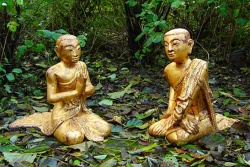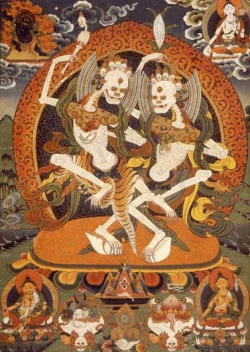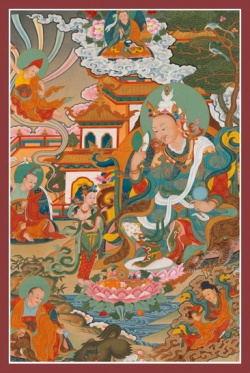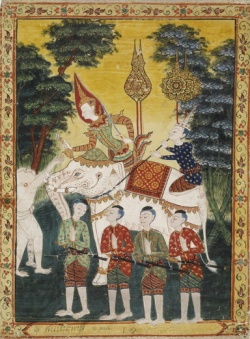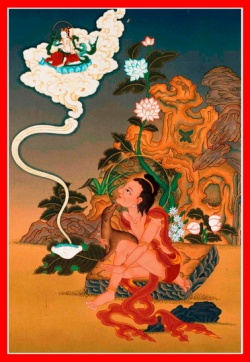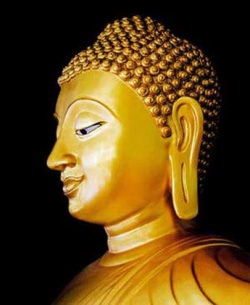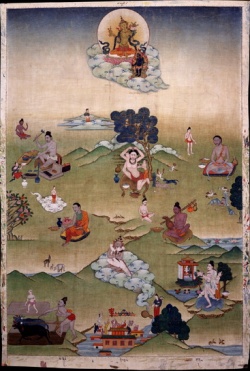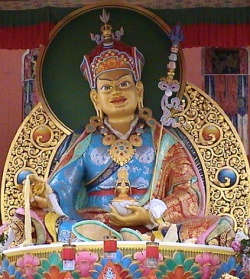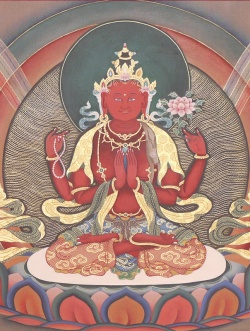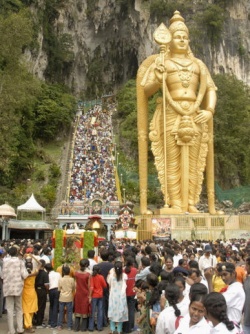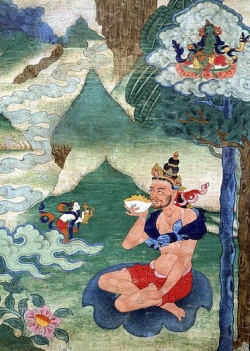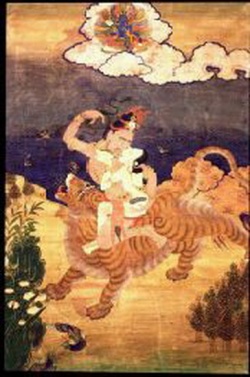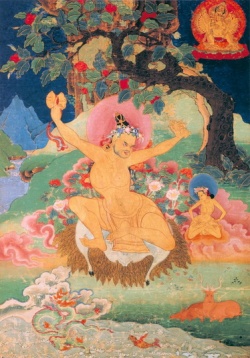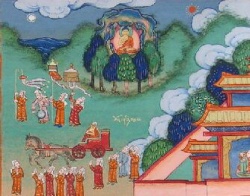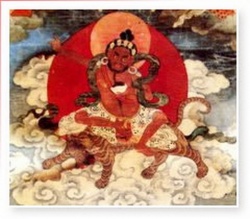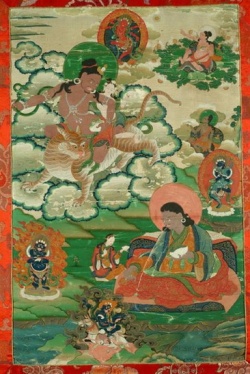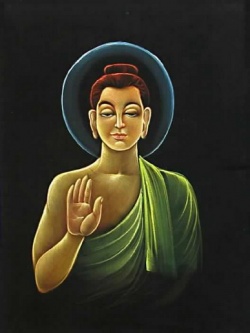The Two Truths (Saṃvṛti-satya and Paramārtha-satya) in Early Yogācāra1
By Dan Lusthaus
Few Buddhist or Indian concepts are more familiar than the notion of two truths, paramārtha-satya and saṃvṛti-satya, typically understood as ultimate and relative truths, or absolute and conventional truths. The modern understanding of these two truths is shaped by relatively late developments in Indian Buddhism (5th century or later), so that earlier formulations, or concurrent formulations have been eclipsed and receive little attention from scholars. To begin to remedy that, I offer the following exposition of how Asaṅga discusses the two truths in his works.
Some initial considerations:
(1) While the two truths do appear by name in many Yogācāra texts, sometimes at strategic junctures, their role in Yogācāra thinking is not nearly as prominent or foundational as in some other Buddhist schools, such as other forms of Mahāyāna, notably Madhyamaka.
(2) While many different types of distinctions between two truths can be found in the full range of Buddhist literature, especially amongst the Ābhidharmikas—and Yogācāra usage reflects many of these (sometimes with new twists)—the not insubstantial scholarly literature on the subject of the two truths tends to focus on a narrow range of interpretations,namely the trajectory stemming from Nāgārjuna’s Mūla-madhyamaka- kārikā ch. 24, most notably .10.2 That trajectory has become the dominant metonymy for Buddhist two-truth theory, leading to the presupposition that all other Buddhist usages of the two-truths either fit within the discourse of this trajectory (and thus one can interpret them from the vantage point of the extent to which they share the concerns and sensibilities of Madhyamaka and its offshoots), or they are atavistic prefigurings in search of the sophisticated developments of this trajectory.
(3) Since Yogācāra usage reflects a much broader spectrum of two- truth theories, much of what it says about them is susceptible to misunderstanding when viewed reductively through the prism of that metonymy. Scholars are aware that prior to and outside this trajectory other versions of two-truth theory occurred, but detailed study of these remains more a desideratum than an established set of data from which to perform analyses. Consequently, Yogācāra deployment of two-truth theory has tended to be either analyzed in terms of its relation to the metonymy (e.g., the relation between two-truths and trisvabhāva theories), or viewed as an appendage, possibly aberrant, to the metonymy, or, because of all the unfamiliar — and thus seemingly incongruous — usages, those passages reflecting understandings outside the metonymy have been largely ignored. To remedy this, a fuller accounting of alternate applications of two-truth theory in Buddhism would be necessary, something which, in a modest, limited way, I shall try to do in this paper.
(4) By achieving a central and foundational status, the metonymic version of the two-truth theory engenders a finite set of familiar philosophemes which can be made to undergo permutations that the tradition and scholars can recount, reiterate and re-parse endlessly. Reducing all of Buddhism to two, and only two truths, everything must be made to fit into one or the other “truth.” Alternate analytic pairs, such as dravya-sat vs. prajñapti- sat, are devalued, or atrophy, or are simply reduced to operations within the lower truth. Deeming one of the two truths to be “higher” and the other “lower,” obvious issues include: What makes one higher than the other? Which of the countless Buddhist models, doctrines and practices are to be sorted into which truth? Is the lower truth good, bad, both or neither? What relation, if any, obtains between both truths, and how specifically does that work? If, as was the tendency within Mahāyāna (Yogācāra included), the highest truth loses all or most of its concrete content, characterized as being beyond predication or meaningful articulation, what sort of “truth” does this contentless abstraction represent, or can it even serve a representational function? Some of the Yogācāra passages to be discussed below make contributions to such questions, but perhaps we may notice additional dimensions as well.
(5) Taking all the above into account, doing justice to how Yogācāra actually used two-truth theory and the terms associated with it (saṃvṛti, vyavahāra, paramārtha, sat, satya) runs the risk of offering something that seems out of synch with current academic discussions. The most common strategy for sidestepping this (as mentioned in 3 above) is to substitute one’s own theorizing for the apparent lack of interest in theorizing about the two truths in Yogācāra, providing them with an argument they themselves never made, while implying that they themselves implied just such a theory. When the two truths are compared to the three natures, that is precisely what is being done.3 As interesting as such speculation might be, it merely reinforces the metonymic version of two-truth theory, and leaves neglected much of what Yogācāra texts themselves do have to say about these terms, which, while less familiar, is not without interest for understanding Buddhist thinking. Therefore what follows is not an “argument” proffered in the name of Yogācāra, nor a metaargument that judges the aptness of Yogācāra twotruths thinking. Instead passages typical of early Yogācāra usage have been collected in an effort to indicate some of what went on in two- truth thinking beyond the metonymic version.
To proceed, a series of observations about the use of the two truths by Yogācāras will be offered, accompanied by representational passages from the Yogācāra literature. I will primarily focus on the writings of Asaṅga, since it is there that we may catch a glimpse of the formative stages of Yogācāra two-truth discourse. A quick survey of some abhidharma ideas on the two truths will be undertaken since they, more so than the more familiar Madhyamakan frames, provide important contextual background for recognizing what is going on in the Yogācāra usage. I will, nonetheless, propose an alternate way to interpret Nāgārjuna’s discussion in MMK 24 that may be closer to what he had in mind before the metonymic version eclipsed all competing models.
I. To privilege or not to privilege the Two Truths
One of the first things one notices in surveying Yogācāra literature is that the pair saṃvṛti-paramārtha is not an indissoluble dyad. Each term can not only be found without the other term anywhere in the vicinity, but each can be found as a component of different lists, some recurring more often than others. To be sure, the pair does occur as a pair — and some examples of that will be discussed below. Both paramārtha and saṃvṛti, however, are often individually included in classificatory lists that omit the other term. Significantly, in Asaṅga’s writings when the two are paired they are always denoted as paramārtha and saṃvṛti, never vyavahāra.
Vyavahāra — taken in the metonymic version as an interchangeable synonym for saṃvṛti4 — is one of a group of terms used by Asaṅga for issues related to the conventional use of language, but it is never paired with paramārtha as far as I can tell.5 (I’ll return to this later.)
Even when the two-truth pair saṃvṛti-paramārtha appear in tandem, the pair is often not treated as either central or foundational, but becomes relativized among other evaluative categories and even other types of “truths” (satya). One of the more striking examples of this is a passage in the Bodhisattvabhūmi section of the Yogācārabhūmi that asks:
How is the Dharma nominally set up with names (= words, nāma) (名法施設建立nāma-dharma-prajñapti-vyavasthānaṃ)?
That refers to what was said by the Buddha in the twelve divisions of the scriptures6, such as the sūtras, etc. Next came the Buddhist Councils.7
Next, [[[Buddha’s]] sayings] were codified.8 Next, they were promulgated.9
This is how the Dharma was nominally set up with names (=words).
How is ‘truth’ (satya) nominally set up in names (= words)?
In innumerable ways.10 For instance:Setting up One Truth: That means no falsity, since there is only one truth without a second.
Or, setting up Twofold Truth: (1) saṃvṛti-satya and (2) paramārthasatya.
Or setting up Threefold Truth: (1) Truth through definitions (lakṣaṇa), (2) truth in speech (vāk), and (3) truth in activities (kriyā).
Or Fourfold Truth: (1) Truth of suffering (duḥkha), (2) Truth of etiology (samudaya), (3) Truth of cessation (nirodha), and (4) Truth of the Way (mārga).11
Or Fivefold Truth: (1) Truth of cause, (2) Truth of effect, (3) Truth of knowing (jñāna), (4) Truth of the known (jñeya),12 and (5) Foremost Truth (agrya-satya).
Or Sixfold Truth: (1) Truth of truth (satya-satyaṃ), (2) truth of the false (mṛṣā-satyaṃ), (3) truth that will be fully understood (parijñeyaṃ satyaṃ), (4) truth of what will be forever extinguished (prahātavyaṃ satyaṃ), (5) truth of direct realization (sākṣātkartavyaṃ satyaṃ), and (6) truth of cultivation (bhāvayitavyaṃ satyaṃ).
Or Sevenfold Truth: (1) truth of savoring the enjoyable (āsvāda satya), (2) truth of misfortune (ādīnava satya), (3) truth of going forth (into the Buddhist life)(niḥsarana-satya), (4) truth of dharmahood (dharmatā-satya), (5) truth of liberation (adhimukti-satya), (6) the Noble Truths, and (7) the non-Noble Truths.
Or Eightfold Truth: (1) truth of suffering as due to conditioning (saṃskāra-duḥkhatā-satya), (2) truth of suffering as due to change (vipariṇāma-duḥkhatā-satya), (3) truth of suffering due to suffering (duḥkha-duḥkhatā-satya), (4) truth of ongoing processes (pravṛttisatya), (5) truth of bringing processes to an end (nivṛttisatya),
(6) truth of adventitious defilements (saṃkleśa-satya), (7) truth of purity (vyavadāna-satya), and (8) truth of correctly applied practices (samyak-prayoga-satya).
Or Ninefold Truth: (1) truth of impermanence, (2) truth of suffering, (3) truth of emptiness, (4) truth of no-self, (5) truth of [the relation between the pratītya-samutpāda links] Ongoing (bhava) and Desire (tṛṣṇā), (6) truth of non-Ongoing and non-desire, (7) truth of expedient means to eliminate those, (8) truth of nirvāṇa with remainder, and (9) truth of nirvāṇa without remainder.
Or Tenfold Truth: (1) truth of oppressive suffering, (2) truth of prestigious wealth and poverty as suffering, (3) truth of suffering from an imbalance of elements, (4) truth of suffering from the dissolution of what is pleasant, (5) truth of suffering from the gross [impediments] (dauṣṭhulya-duḥkha-satya), (6) truth of karma, (7) truth of kleśa, (8) truth of careful thinking about the Correct-Dharma one has heard (tathā-śravaṇa-yoniśo-manaskāra-satya),13 (9) truth of Right View, and (10) truth of the fruit of Right View. In such ways do Bodhisattvas nominally set up truths in words (nāma). You should know that such distinctions can be extended without limit (apramāṇa).14
So there are potentially innumerable ‘truths,’ with the set saṃvṛti- paramārtha only being one of them.
There are several interesting dimensions to the way Asaṅga formulates this. The question arises in a section of the Yogācārabhūmi that explicitly examines the question of how language works — a concern that Asaṅga repeatedly returns to. Here Asaṅga is asking how “truth” is constructed or transferred over to words (nāma). His preamble clearly frames it as a social process, a process of group construction of conventions. Buddha speaks. That is only the first step. That speech is grouped into various categories, worked over through a variety of processes, collected, collated, edited, codified, modified, and made communicative by groups of people, such as Buddhist Councils. And unlimited numbers or configurations of “truths” can be extracted and codified, put into words, on that basis. Truth(s), when put into words, including the two truths, are conventions. The insightful bodhisattva can generate them ad infinitum. They are truths to the extent that they communicate, via conventions, communally, some sense of Buddha’s understanding, which he himself initially put into words in the same manner, since language is precisely engaging in conventionality par excellence.
Lest we be tempted to assume too quickly that when mentioning the two truths this passage is evoking the metonymic version, or that the twotruth pair appearing so high up on the list indicates a near-primacy rather than mere enumerative order, we now turn to the first chapter of the second of two parts of the Abhidharmasamuccaya, appropriately entitled Satya- viniścaya (determination of truth), though satya here denotes the Four Noble Truths, which are the subject of this chapter. Discussing the first Noble Truth, “suffering” (duḥkha), Asaṅga lists eight kinds of suffering:15
[1] suffering of birth (jātiduḥkha), [2] of aging (jarā), [3] of disease (vyādhi), [4] of death (maraṇa), [5] suffering associated with what is unpleasant (apriyasamprayoga), [6] suffering of separation from what is pleasant (priyaviprayoga), [7] suffering if one does not obtain what one desires (yad apīcchan na labhate), and [8] in brief (saṃkṣiptena) the five aggregates of attachment (pañcopādānaskandha)…
Asaṅga then provides further explanations for each of the eight, followed by a list of six types of suffering16 to which, he says, the eight can be reduced. “Whether six or eight, it is the same thing” (Boin-Webb, 2001,
85; ṣaḍ samānāny aṣṭau bhavanti; 若六若八平等平等). This is followed with the well-known list of three types of suffering: “mere suffering” (duḥkha-duḥkhatā), “suffering caused by transformation” (vipariṇāma- duḥkhatā), and “suffering caused by conditioning” (saṃskāra-duḥkhatā). He explains:
The eight kinds of suffering are included in them… the sufferings of birth, aging, disease, death and association with what is unpleasant are mere sufferings…; the sufferings of separation from what is pleasant and not obtaining what one desires are suffering caused by transformation…; in brief, the five aggregates of attachment are suffering as suffering caused by conditioning…. (Boin-Webb, 2001, 85)
The two-truth pair now make their brief appearance in this chapter.
It is said that there are two forms of suffering: suffering according to conventional truth (saṃvṛtisatya) and suffering according to ultimate truth (paramārthasatya).
What is suffering according to conventional truth and what is suffering according to ultimate truth? From “the suffering of birth” up to “the suffering of not obtaining what one desires” — those are suffering according to conventional truth. “In brief, the five aggregates of attachment are suffering” — that is suffering according to ultimate truth. (Ibid.)
It is worth pointing out that the introduction of the two truths is prefaced by “it is said that…” (yad uktaṃ dvividhe duḥkhe iti, 如說二苦), framing what is to follow as thoroughly enmeshed in language and retelling. Asaṅga is often very sensitive to the interplay of language and that towards which language purports to point. That is the main theme of the Tattvārtha chapter of the Bodhisattvabhūmi. As we’ll see in a moment, distinguishing between vastu, prajñapti, dravya, etc., are crucial to his analysis. Also worthy of note is that in the passage just cited Paramārtha- satya is given clear and specific content, viz., the five appropriational skandhas (skandha-upādāna) which Asaṅga had just explained are synonymous with saṃskāra-duḥkhatā, “suffering caused by conditioning.”
This indicates that paramārtha signifies a type of discourse or understanding that points to what, below the obvious surface, is actually transpiring. It is language speaking with precision and true accuracy.
The first seven types of duḥkha are ways of thinking about duḥkha; the eighth, the dynamics of the five appropriational skandhas — that is, the way a person is — is, at bottom, what duḥkha is, the first seven merely indicating facets of those skandhas. The first seven still contain traces of selfhood thinking (what’s pleasant to me, my goals, obstructions to me, etc.); the eighth indicates purely impersonal processes driven by appropriation (upādāna).
Paramārtha here has specific content, namely the appropriational dynamics of the skandhas. To see things from that perspective is to see things as they are. This, as we’ll see, is not an uncommon usage. However, Asaṅga elsewhere will undermine this type of application of paramārtha-satya. We will return to this as well.
Finally, and this is perhaps the most significant point to take away from this passage, the two truths are explicitly treated as reductive forms of discourse that are not intended to replace or eclipse the other models (the eight, six and threefold enumerations), but are merely summations, shorthand (saṃkṣiptena) from which the other models may be extrapolated at any time. This illustrates the point made in the Yogācārabhūmi passage about the ten truths, namely that Dharma-speech can expand or contract, as the need arises. The implication seems to be that the deeper one’s understanding, the less that needs to be said or enumerated. But given the imperative to “benefit others” that is one of the signature notions of Mahāyāna, the ability to expand and enumerate on concise doctrinal statements is indispensable. Truths can be extrapolated, or they can be reductive. One might say that saṃvṛti-satya and paramārtha-satya in this case are both cases of vyavahāra.
Saṃvṛti and/or paramārtha are commonly found listed along with additional sat-s or satyas. For instance, the final section of the Yogācārabhūmi states:
Briefly it is said that there are three types of existents (sat).
(1) dravyasat, (2) prajñapti-sat, and paramārtha-sat.
略 說 有 三 種 有 。一 者 實 有 。二 者 假 有 。三 者 勝 義 有 。
(T.30.1579.878c19-21)
The passage goes on to define dravya-sat as the denotative use of language through which a thing (vastu) can be obtained or realized (*adhi √gam). A dravya is explained as a thing or process that is always actually operating, to which such words refer. “For instance, rūpa, and so on, amongst groups of dharmas” (如於色等諸法聚中).17 According to this
passage, things such as vehicles, forests, grass, trees, robes, food can be denoted this way.
Prajñapti-sat consists of six types: (1) prajñapti of a group (*sāmagrī-prajñapti), (2) prajñapti as cause (hetu-prajñapti), (3) prajñapti as effect (phala-prajñapti), (4) prajñapti of what has been done, (5) prajñapti of situations (*avasthā-prajñapti), and (6) positing something where it is not present (*apekṣā- prajñapti).18 After explaining each of the six in greater detail, it asks: What is paramārtha-sat? It is that from which all language and all prajñaptis are forever eliminated, it is apart from conceptual proliferation (prapañca) and apart from conceptual construction (kalpanā). It is expressed through skillful means (upāya-kauśalya) [by such terms as] dharmatā, tathatā, bhūtakoṭi, śūnyatā, nairātmya, and so on, as [was discussed in] the Bodhisattvabhūmi, in the Tattvārtha [[[chapter]]], concerning the fourth type (of knowledge of real things),19 viz. the cognitive sphere completely purified of obstructions to the knowable (jñeyāvaraṇa) (attained by high-level Bodhisattvas and Buddhas) (jñeyāvaraṇa-viśuddhi-jñāna-gocara). You should know that images (*nimitta) of it are contradictory to the higher (truth).
You ought to know it is not an existent.20
《瑜伽師地論》卷 100:「云何勝義有。謂於其中一切名言 一切施設 皆悉永斷。離諸戲論。離諸分別。善權方便。說為法性,真如,實際, 空,無我,等。如菩薩地 真實義品 第四所知障淨智所行真實。應知 其相。與上相違。當知非有。」 (T.30.1579.879a20-25)
We notice that saṃvṛti did not appear in this discussion — instead dravya-sat and prajñapti-sat accompany paramārtha-sat. Paramārtha- sat can be articulated, via expedient means, through synonyms, such as tathatā, dharmatā, etc. Such strings of synonyms for paramārtha are common occurrences in Asaṅga’s texts, perhaps the best known example being the synonyms (paryāya) for śūnyatā in Madhyānta-vibhāga 1:15: tathatā bhūtakotiśca-animittam paramārthatā | dharmadhātuśca paryāya śūnyatāḥ samāsataḥ (“In sum, the synonyms for emptiness are tathatā, the limits of reality [[[bhūtakoṭi]]], animitta, paramārthatā, and dharmadhātu.”)
Prefiguring Dignāga’s definition of perception as thoroughly excluding all forms of language and conceptualization (kalpanāpoḍha), Asaṅga here offers the same exclusions to define paramārtha-sat, adding prapañca, prajñapti, and language as a whole to the list of exclusions.
The cross-reference to the Tattvārtha chapter is intriguing, since not only does Asaṅga define there the type of purified cognition available only to bodhisattvas and Buddhas (and not to Śrāvakas, Pratyekabuddhas, or others) — namely the fourth type he refers to here — but the entire chapter is concerned with the relation between language (prajñapti, artha, etc.) and non-linguistic, non-conceptual realities (tattva, dravya, vastu, etc.). He emphasizes more than once that all Buddhist discourse, up to and including terms such as “mahā-parinirvāṇa,” is prajñapti.
At the same time he firmly rejects nominalism, encouraging us to cognize beyond linguistic-conceptuals in order to see tattvas as they truly are
— but in a non-dual manner that doesn’t “reject” the linguistic sphere. Hence the chapter’s title: tattva + artha, “things” and the “words that refer” to them.
One or the other term — saṃvṛti or paramārtha — can also be used without the other in different evaluative lists or mātṛkās. For instance, in Abhidharmasamuccaya Asaṅga uses the following thirteen items as an evaluative mātṛkā for determining aspects of kuśala (beneficial karmic activity), in which paramārtha is the fifth item: distinct nature (svabhāva), connections (sambandha), outcome (anubandha), emergence (utthāna), ultimate significance (paramārtha), attaining birth (upapattilābha), application (prayoga), veneration (puraskāra), granting favor (anugraha), receiving (parigraha), counteracting (pratipakṣa), tranquility (upasama) and the result that flows from a process (niṣyanda). Each is applied to kuśala. For instance: “What is favorable [[[kuśala]]) by nature? The eleven mental associates (caittas) beginning with faith (śraddhā),”21 i.e., the eleven kuśala caittas of the Yogācāra list of dharmas.22 What is kuśala as outcome? Its own habitual tendencies (vāsanā). And so on. For paramārtha, Asaṅga states: “What is favorable as ultimate reality? It is suchness (tathatā)”.23
A slightly shorter and slightly different list is used to analyze akuśala (non-beneficial): distinct nature (svabhāva), connections (sambandha), outcome (anubandha), emergence (utthāna), ultimate significance (paramārtha), attaining birth (upapattilābha), application (prayoga), veneration (puraskāra), offending (upaghāta), receiving (parigraha), counter-case (vipakṣa), and obstructive adversity (paripantha). For instance: “What is akuśala as outcome? Its own habitual tendencies (vāsanā).” For paramārtha, Asaṅga asks: “What is akuśala as ultimate reality? The whole continuity of existence (sarva-saṃsāra)”.24
The same type of mātṛkā is then applied to the karmically neutral (avyākṛta). “What is neutral as ultimate reality? Space (ākāśa) and cessation without acquired knowledge (apratisaṃkhyā-nirodha)”.25
The paramārtha (ultimate significance or goal) of kuśala is tathatā; the paramārtha (ultimate referent) of akuśala is the entirety of saṃsāra; and what avyākṛta figuratively implies in an ultimate sense are concepts of the unconditioned as neutrality, non-obstructive, non-productive,
such as ākāśa and apratisaṃkhyā-nirodha.
Another example: Using a fivefold distinction (nimitta, nāma, vikalpa, tathatā, jñāna), Asaṅga, in the Yogācārabhūmi (fascicle 72), asks whether each of these should be called saṃvṛti-sat or paramārtha-sat. But before asking about the familiar two satyas, he asks whether they should be
considered existent or nonexistent (sat or asat), and then whether each is
dravya-sat or prajñapti-sat.
[Sat or Asat?]
Q: Should a nimitta be called an existent (sat) or a nonexistent (asat)?
A: It should be called an existent.
Q: As to what is established because of positing (prajñapti) self-natures (svabhāva) or particularity (viśeṣa), should this be called an existent?
A: It should be called a nonexistent.
Q: As to discriminating the range of experienced objects (所行境, *gocara, *cāriṇyâlambana), should this be called an existent?
A: Such should be called existent. For a bodhisattva who possesses the nature (for attaining Buddhahood), because he has attained skillfulness
(善巧 *kauśalya, *kuśala), there are images (nimitta) that are analytically- perceived (善記 *vyākaraṇa, *vyā √kṛt) as existent, analytically-perceived as nonexistent, analytically-perceived as both existent and nonexistent, and analytically-perceived as neither existent nor nonexistent. Because he analytically-perceives in this way, he is far from the two extremes of increase or decrease, and so practices the middle way; the dharmadhātu is [the cognitive range] for his skill.
Q: This image (nimitta) when considered as a referent (artha) of language, should it be called existent? When considered as a referent apart from language, should it be called existent?
A: Both referents should be called existent. Why? If language is set up and stable (pada-sthāna), such that referents (are apprehended) by means of
language, then one should say (the referent) is existent. If [one realizes] that the designation of a self-nature (svabhāva-prajñapti) or the designation of a particular (差別假立 viśeṣa-prajñapti) refers to [self-natures and particularites as] unconsummated (apariniṣpanna),26 just in this way the referent that is separate from language should be called existent.
Q: Should suchness (tathatā) and correct cognition (jñāna) be called existent or non-existent?
A: They should be called existent.
[Dravya-sat or prajñapti-sat?]
Q: Should nimittas be called dravya-sat or prajñapti-sat?
A: During [certain] practices they should be called dravya-sat.
During [certain other] practices they should be called prajñapti-sat.
There are nimittas of both types.
Q: Should name (= word, nāma) be called dravya-sat or prajñapti-sat?
A: It should be called prajñapti-sat since it is only nominally posited of the
nimitta.
Q: Should vikalpa be called dravya-sat or prajñapti-sat?
A: It is both types of sat.
Q: Should tathatā be called dravya-sat or prajñapti-sat?
A: It should be called dravya-sat, since it is classified as paramārtha.
Q: Should correct cognition (jñāna) be called dravya-sat or prajñapti-sat?
A: It should be called both sat-s. As to these, [correct] cognition [itself]
is dravya-sat. If the cognition entails classifying citta and caittas,
naming them as “cognition,” [etc.,] then call it prajñapti. Hence [[[cognition]]) possesses both types of sat.
[Saṃvṛti-sat or paramārtha-sat?]
Q: Should nimittas be called saṃvṛti-sat or paramārtha-sat?
A: Nimittas should be called saṃvṛti due to two causes and conditions: (1) Because they produce adventitious defilements (āgantuka-kleśa); (2) because [they stimulate] the positing (*prajñapti) of a representational [[[realm]]) based on utilitarian value (bhājana).
Q: Should nāma be called saṃvṛti-sat or paramārtha-sat?
A: It should be called saṃvṛti-sat due to three causes and conditions: (1) Because it produces adventitious defilements; (2) because [it stimulates] the positing of a representational [[[realm]]) based on utilitarian value; (3) because it is the basis (āśraya) of figurative language (施設 *vāk, *upacāra, *prajñapti, *abhidhāna, *vyavahāra, etc.).
Q: Should vikalpa be called saṃvṛti-sat or paramārtha-sat?
A: It should be called saṃvṛti-sat due to four causes and conditions: (1) Because it produces adventitious defilements (āgantuka-kleśa); (2) because [it stimulates] the positing (*prajñapti) of a representational [[[realm]]) based on utilitarian value (bhājana); (3) because proclivities (anuśaya) are consequent on conventional language (vyavahāra),
(4) because Awakening (prati-√buddh; vibuddhi) is consequent to conventional language (vyavahāra).
Q: Should tathatā be called saṃvṛti-sat or paramārtha-sat?
A: It should be called paramārtha-sat since it is a pure cognitive object (*ālambana-viṣayatva).27
Q: Should correct cognition (jñāna) be called saṃvṛti-sat or paramārtha-sat? A: The first cognition [which simply and directly sees the object) is called paramārtha-sat; the second cognition [which reflects on and conceptually analyzes the components of the initial cognition) should be called both sat-s.28
II. Language: Saṃvṛti, vyavahāra, prajñapti, sāṃketa, etc.
Prajñapti is a wide-ranging term, deployed in multifarious ways with many different meanings and implications. As above, it can be contrasted with dravya (a “real” process that is in some sense irreducible, not a “substance”). Prajñapti may indicate a composite of distinct dravyas conflated under a single umbrella term or concept, such as conflating the five skandhas into a single “person” (pudgala), or conflating wheel, axle, etc., into a “chariot.” By this definition, any “whole” composed of parts is
a prajñapti. Prajñapti can also signify a purely nominal entity that exists in “name” only, such as an eternal, invariant “self” (ātman).
Sometimes texts distinguish between prajñapti and saṃvṛti, since, despite both involving and being implicated in language to some extent, dravyasat may also be saṃvṛti; in such instances, since dravya and prajñapti are mutually exclusive, obviously prajñapti-sat would be excluded.
Since, sometimes, prajñapti is used in certain Buddhist texts as a synonym for vyavahāra, and prajñapti is differentiated from saṃvṛti, one may speculate that a distinction between saṃvṛti and vyavahāra was also assumed or possible, though I haven’t found a passage in a Yogācāra text that makes this fully explicit. Nonetheless, the two-truths, for Yogācāra, are just two of many truths, as shown above.
In the cintāmayī-bhūmi of the Yogācārabhūmi, Asaṅga defines “speech using linguistic signs” (sāṃketika vāda) thus:
Speech whose conventions are shared by the multitude (sāṃketiko vādaḥ),29 is sixfold: (1) features of things (vastu-lakṣaṇa), (2) features of the known (vijñeya-lakṣaṇa), (3) features of purity, etc., (śubhādi- lakṣaṇa), (4) pleasant, etc., features (anugrahādi-lakṣaṇa), (5) features of conventional language (vyavahāra-lakṣaṇa), and (6) features of false assumptions (mithyāpratipattyādi-lakṣaṇa).
Linguistic signs can be used to articulate and give linguistic form to actual things (vastu); what one is conscious of (vijñeya); notions of purity and impurity (śubhāśubha); evaluative judgements such as deeming certain things to be pleasant, unpleasant, etc.; discussions of language itself as the common medium of communication; and as a means for giving one’s false assumptions, presuppositions and opinions the illusion of reality. Signs (sāṃketa), in other words, entail a spectrum stretching from discussing actual things, to analyzing and evaluating such articulated “things,” to giving life to erroneous ideas (as well as the tools for analyzing why those ideas are erroneous). As Asaṅga explains this: Features of things (vastu-lakṣaṇa) are grasped by consciousness (vijñāna). Features of the known (vijñeya-lakṣaṇa) are grasped by focusing attention (manaskāra) arising from consciousness. The pure and wondrous, etc., is grasped by contact (sparśa); the pleasant, etc.,
is grasped by pleasure-pain sensation (vedanā); conventional linguistic marks (vyavahāra-nimitta-lakṣaṇa) are grasped by associative- cognizance (saṃjnā); and the features of false assumptions are grasped by volition (cetanā).30
Five of the six “graspers” mentioned here (manaskāra, sparśa, vedanā, saṃjnā, and cetanā) are the five sarvatraga caittas, that is, the mental associates that are always active in every and any cognition. The remaining “grasper,” consciousness (vijñāna), would be classified as a citta dharma, not a caitta. Here we have an example of vyavahāra appearing in a list
that has no obvious link to the two truths. Importantly, vyavahāra is linked with saṃjnā, which besides its well-known use as the third of the five skandhas (and, as is obvious, the five sarvatraga caittas echo the five skandhas, replacing vijñāna with manaskāra and rūpa with sparśa), always carries “linguistic” connotations in Asaṅga’s texts, drawing on, amongst other things, the sense of saṃjnā developed in the Pāṇinian grammatical system. By associating not only consciousness, but each of
the sarvatraga caittas with sāṃketa, Asaṅga informs us that many levels of our cognitive processes are always poised to grasp linguistic signs. Sāṃketa is only one type of language usage, the sharing of conventional signs. Sāṃketa here is not a subset of vyavahāra; it is the other way around: vyavahāra is a subset of sāṃketa. Vyavahāra, which is a term
Asaṅga uses often, appears in numerous models similar to this one, in a variety of configurations with other terms; but never, as far as I’ve discovered, paired with paramārtha as the second ‘truth.’
III. Vyavahāra and saṃvṛti / sammuti
As previously mentioned Nāgārjuna in MMK treats vyavahāra and saṃvṛti as synonyms — or does he? Might the vyavahāra in the famous MMK 24:10 be a sub-category of saṃvṛti (i.e., a deliberate echo of the Palisammuti),reiteratedfromtheopponent’sevocationofsaṃvyavahārāṃ at 24:6?31 Nāgārjuna repeats the opponent’s term — sarva-saṃvyavahārāṃ
— at MMK 24:36, turning the opponent’s criticism back on the opponent with nearly the same language used by the opponent. Non-madhyamakan literature,including Yogācāra texts, suggests that it might.
Here are the passages in MMK 24 in which either vyavahāra or saṃvṛti appear:
śūnyatāṃ phalasadbhāvam adharmaṃ dharmam eva ca | sarvasaṃvyavahārāṃś ca laukikān pratibādhase || MMK 24:6 [The opponent complains:]
Your emptiness is an assault on the actual existence of the fruit [of practice], and even on adharma and dharma (improper and proper actions), as well as all the conventions of the world. dve satye samupāśritya buddhānāṃ dharmadeśanā | lokasaṃvṛtisatyaṃ ca satyaṃ ca paramārthataḥ || MMK 24:8 [[[Nāgārjuna]] replies]
The teaching of the Dharma of the Buddhas is entirely based on two truths; worldly conventional truth (loka-saṃvṛti-satya) and the ultimately true. vyavahāram anāśritya paramārtho na deśyate |paramārtham anāgamya nirvāṇaṃ nādhigamyate || MMK 24:10
Without vyavahāra as a basis, paramārtha cannot be taught; if paramārtha is not realized, nirvāṇa will not be ultimately realized. sarvasaṃvyavahārāṃśca laukikān pratibādhase |
yatpratītyasamutpādaśūnyatāṃ pratibādhase || MMK 24:36||
You are assaulting all the conventions of the world if you assault the emptiness [related to] conditioned co-arising (pratītya-samutpāda).
In other words, Nāgārjuna contends, it is not emptiness that threatens the everyday world of conventions, the moral (dharma and adharma) codes and sensibilities that these conventions entail, nor the actual attainment of the fruit of practice; emptiness understood in terms of conditioned coarising contextualizes, but never destroys them. It is failing to properly understand conditioned co-arising and emptiness that threatens the peaceful fulfillments of the ordinary world.
It may be significant that vyavahāra is not explicitly called a “truth” (satya) in these passages. The text never says vyavahāra-satya. Only saṃvṛti, in its single appearance in MMK at MMK 24:8c, is called saṃvṛti-satya.
If — and this is merely speculation — vyavahāra and saṃvṛti were not isomorphic synonyms for Nāgārjuna, but rather vyavahāra was a subset of saṃvṛti, “just talk that communicates,” as it were, then not only its pedagogic value, but its necessity, even for Madhyamaka’s own debate method, suddenly becomes clearer.
As is well known, saṃvṛti is a distortive Sanskritization of the Pali term sammuti, which, like the Pali vohāra (Skt. vyavahāra), means conventional discourse. While some have traced explicit discussions of the nirukta of saṃvṛti as “covered” or “enveloped” only to Candrakīrti (7th–8th century), that interpretation is already discussed in the Mahāvibhāṣā.
As Dhammajoti (2007, 95 n.33) notes: “Already in the MVŚ (548b), we are told that the Grammarians (śabdika) take this to be from √vṛ, ‘to cover’: ‘This saṃvṛti-satya is concealed by ajñāna, like that which is inside a vessel is concealed/covered by the vessel.’ The Sanskrit Buddhist tradition generally interprets it in terms of saṃ + vṛt/vṛ.”
This etymology is also found in Yogācāra-related texts.32
IV. Conventions and Abhidharma
Yogācāra texts deploy the two truths in accord with the conventions of various literatures. The early Yogācāra literature (e.g., Asaṅga) more often than not tends to follow abhidharma usages. Yogācāra uses the two truths (alone or in conjunction with additional truths) in different ways in different passages, reflecting the sources of the ideas and models they are adopting. So a study of Yogācāra usage should also be a study of the different usages by different Buddhist schools and literatures over time. (I will not attempt a comprehensive survey here, however, but will give a few illustrations of shifting meanings.)
Since the excellent study of Sarvāstivāda Abhidharma by Bhikkhu KL Dhammajoti (2007) contains much pertinent material, I take the liberty of quoting it at length:
Succinctly, an Ābhidharmika is one who specializes in the abhidharma and takes the abhidharma as the final authority. For him, the abhidharma
is definitive (lākṣaṇika) and represents the true intention of the Buddha, taught at the level of absolute truth (paramārtha-satya), with fully drawn out meanings (nītārtha). In contrast, the sūtra-s do not represent the Buddha’s true intention (ābhiprāyika). They generally represent the expedient (aupacārika) teachings whose meanings are yet to be
fully drawn out (neyārtha). (Dhammajoti, 18-19)
This is an extremely important issue, not just for Abhidharma but for Yogācāra as well. Above all, the two truths serve as a value system, a prioritizing of some things over other things. Saṃvṛti and paramārtha are evaluative labels, for things in general, but most especially for the components of Buddhist doctrine. The value or degree of definitiveness the truths assign are not necessarily ontological — though their use doesn’t exclude ontological determinations either. Nonetheless, they are not limited to ontological concerns. The Yogācārabhūmi, and indeed many Yogācāra texts, are more concerned with linguistic issues, linguistic-conceptual problems and their solutions, the relation of words (nāma) to real things (vastu), etc. Certain teachings, models, concepts, etc., are deemed definitive, of the highest order, while others are given a lower, provisional status. Hence saṃvṛti and paramārtha are also synonymous with or parallel to the pair nītārtha (explicit) and neyārtha (implicit), especially when in hermeneutic contexts.
Put another way, saṃvṛti and paramārtha are themselves hermeneutic labels for evaluating how specific items and qualities treated within the variety of Buddhist teachings are to be classified and hierachized, and as such are synonymous in function to the neyārtha-nītārtha distinction (some texts make this explicit33). Which of the teachings are provisional, and which are definitive? As the sprawling mass of Buddhist literature and its proliferating categories exploded exponentially, generating countless new models and doctrinal enumerations, many of which did not fit well or easily with other models, finding keys to how to make all cases of buddhavacana accord with each other became an increasingly urgent matter.
Is pratītya-samutpāda — understood as the twelve links — a provisional or definitive teaching? Which interpretation of pratītya-samutpāda was most accurate and best accounted for things as they are? Which teachings were primarily therapeutic expedients that served as transitional considerations (transitioning to a higher or deeper understanding)? Teachings that one school considered definitive, another might declare merely transitional.34 In short, the saṃvṛti-paramārtha distinction is less about levels of reality or even levels of epistemological approaches, and rather is about classification of Buddhist doctrine by Buddhists. That entailed questions of the ‘reality’ described by various Buddhist teachings and those perspectives which were condoned or rejected or given provisional status, and even allowed for “unsayable” realities that resisted rational articulation (another gift from the Vātsīputrīyas).
For each type of Buddhism, paramārtha finally stands for the definitive statement by a thinker or school on what ultimately is the case and goal of Buddhist thinking and practice. To attain full enlightenment is to realize paramārtha. Everything else is saṃvṛti, and any goal wrongly envisioned as paramārtha will lead to less than fully satisfactory consequences.
[Quoting Saṅghabhadra’s Nyāyānusara:] “By sūtra is meant that which subsumes and contains all the words which accord with the firm principles of both the saṃvṛti- and paramārtha-satya-s. Sūtra-s in this sense are either discoursed by the Buddha or the disciples, for [the latter] discoursed because [the content was] approved by the Buddha.”35 (Dhammajoti, 21) Buddha’s speech is both saṃvṛti and paramārtha. The same is true of the subsequent formulations and reformulations by his disciples, and by
extension, all subsequent clear-thinking Buddhists. By declaring the sūtras to contain both types of truth, Saṅghabhadra is inviting us to engage them as a hermeneutic enterprise.
Dhammajoti (p. 16 n.14) writes: “AKB [[[Abhidharmakośa-bhāṣya]]) 459. Also cf. MVŚ [[[Mahāvibhāṣā]]) 917c, where the Saddharma is subdivided into the conventional and the absolute (paramārtha) ones. The former comprises the verbal teachings of the tripiṭaka; the latter is the noble path, i.e., the outflow-free indriya, bāla, bodhyaṅga and the mārgāṅga.”36
Here, as we saw in oneof theexamples from Asaṅga’sAbhidharmasamuccaya, paramārtha refers to specific doctrinal content, content that should be taken as ultimately true.
Dhammajoti translates the following discussion in Mahāvibhāṣā on the relation between the two truths: Question: Is the fact of conventionality (世俗性; *saṃvṛtitva?) in the conventional [[[truth]]) existent from the standpoint of the absolute truth or is it non-existent from the standpoint of the absolute truth?...
Answer: It should be said that the fact of conventionality in the conventional [[[truth]]) is existent from the standpoint of the absolute truth. If the fact of conventionality in the conventional [[[truth]]) is/ would be non-existent from the standpoint of the absolute truth, then the Buddha’s discourse on the two truths would be false…
Question: If so, there should be only one truth, the absolute truth. Answer: There indeed is only one truth, the absolute truth. Question: If so, why are two truths established?
Answer: The two truths are established in terms of differences in perspective (差別緣; ‘different reasons’), not in terms of substance [[[實]] 事 vastu): In terms of substance, there is only one truth, the absolute truth; in terms of difference in perspective, two types [of truth) are established. The absolute truth is not established from the same
perspective from which the conventional truth is established. The conventional truth is not established from the same perspective as the absolute truth…
Question: Is it also possible to designate the conventional and the absolute as being each distinct, without the two mingled?
Answer: It can also be so designated. How is this? According to Venerable Vasumitra: The word that reveals is conventional; the dharma that is revealed is absolute. He states further: that which accords with conventional usage37 is conventional [[[saṃvṛti]]); that which accords with what the Āryas say is absolute. According to the Bhadanta: The speech generated from a thought that not untrue, speaking of things like sentient beings, vase, garment, etc., is conventional truth. The speech generated from a thought that is not untrue, speaking of principles such as conditioned co-arising, etc., is absolute truth….38
(Dhammajoti, 78f; square brackets mine) Dhammajoti (pp. 79-80) translates the distinction that the Abhidharmakośa- bhāṣya draws between saṃvṛti and paramārtha thus:
That, the buddhi of which does not arise when it is broken into parts (avayavaśo bhinne), is conventionally existent; for instance, a pot.
For therein, when it is broken into pieces, the buddhi of a pot does not arise. And therein, when the [constituent] dharma-s [of a thing] are mentally removed (apohya), the buddhi of it does not arise — that too is to be understood as a conventionally existent; for instance, water.
For therein, when the dharma, rūpa, etc., are removed mentally,the buddhi of water does not arise.
A conventional notion (saṃvṛti-saṃjnā) is made with regard to those very things. Thus, those saying that a pot or water exists by virtue of convention speak truly and not falsely; thus this is conventional truth (saṃvṛtisatya).39
Absolute truth (paramārthasatya) is other than this. Therein, even when [a thing] has been broken, the buddhi of it definitely arises and likewise, even when its [constituent] dharma-s are removed mentally — that is [to be understood as] an absolute existent (paramārthasat). For instance rūpa: for, therein, when the thing is
broken into the atoms (paramāṇuśaḥ), and when the [constituent] dharma-s taste, etc., have been removed mentally, the buddhi of the intrinsic nature of rūpa definitely arises. Vedanā, etc., are also to be seen in this way. This is called absolute truth as the existence is in the absolute sense (etat paramārthena bhāvāt paramārthasatyamiti).40
When mental, conceptual features are removable from something, excluded, if a cognition (buddhi) of it does not arise, then it is saṃvṛti- satya. Leaving aside possible implications of this for Dignāga’s apoha theories (he clearly draws on similar ideas in his Ālambana-parīkṣā), what we find is that, for Vasubandhu, saṃvṛti here is being defined in more or less the same terms by which prajñapti is usually differentiated from dravya, thereby implying an equivalence or strong similarity
between saṃvṛti and prajñapti.
What is notable is that, even here, in his supposedly pre-Yogācāra days, Vasubandhu is using buddhi — i.e., a knowledge-producing cognition — as the criterion by which the truths can be distinguished from each other, viz., the ability to form a clear cognitive object, even an intellective rather than perceptual one. What, after the conceptual features have been removed, still produces a buddhi, is paramārtha. If a buddhi fails to arise from a deconstructed object, then that object is saṃvṛti. Since he
explicitly indicates that the paramārthic cognition of a rūpa is one from which sensations like “taste,” have been excluded, this implies that the irreducible cognitive object of a paramārthic buddhi is primarily intellective, rather than sensate, even when that of which it is a cognition, such as a material object, is itself a sensory item. Note the Sarvāstivādin sense of what makes something real is its “intrinsic nature” which is atemporal in the sense that a buddhi of it arises even when the features which arise and cease temporally are excluded (apohoya).
It is exactly this abstract intellective “idea” of things such as rūpa, etc., that Asaṅga criticizes, as we’ll see shortly when we turn to his
Paramārtha gāthā. The idea (saṃjnā) of rūpa, etc., is prajñapti, not 實 物有 (dravyato ‘sti), nor is it paramārtha-sat. Such ideas, Asaṅga says, are “only parikalpita-svabhāva.”
Saṅghabhadra carries Vasubandhu’s idea one step further (Dhammajoti, 81): This is divisible into two: What exists truly (dravyo ‘sti) and what exists conceptually (prajñaptito ‘sti), the two being designated on the basis of saṃvṛti-satya and paramārtha-satya, [respectively]. If, with regard to a thing, a buddhi is produced without depending on anything
else, this thing exists truly — e.g., rūpa, vedanā, etc. If it depends on other things to produce a buddhi, then it exists conceptually/relatively
— e.g., a vase, army, etc.
Those that exist truly are futher divisible into two: Those that have only their essential natures (svabhāva/svarūpa) and those that, [in addition,] have activities (kāritra). Those that have kāritra are again of two types: with or without function (sāmarthya/vyāpara/ śakti)… Those that exist relatively [[[prajñapti-sat]]] are also of two types: having existence on the basis of something real [dravya-āśraya] or on something relative [prajñapti-āśraya], like a vase and an army, respectively.41
There are all sorts of problems, as well as interesting ideas, in this short passage, but we will move on.
Dhammajoti (77-78) translates the following discussion from the Mahāvibhāṣā on the various theories held by different Ābhidharmikas on the existent. Words in square brackets are added by me.
Regarding the existents, some say that they are of two kinds:
1. Existents as real entities (dravyataḥ sat) — the skandha, āyatana, etc.;
2. Existents as concepts (prajñaptitaḥ sat) — male, female, etc.
Some say they are of three kinds: 1. What exists relatively — a given thing [[[vastu]]) exists relatively to this but does not exist relatively to that; 2. What exists by virtue of an assemblage — a given thing exists here but does not exist there; 3. What exists at some given time — a given thing exists at this time but does not exist at another time.
Some say they are of five kinds: 1. what exists in name (only) [nāma-sat 名有] — a tortoise’s hair, a hare’s horn, a garland of [sky] flowers, etc.; 2. what exists as a real entity (dravyato ‘sti [實有]) —all dharma-s each of which is abiding in its own-nature (svabhāva);
3. what exists conventionally [[[prajñapti-sat]] 假有] — a vase, garment, vehicle, army, forest, house, etc.; 4. what exists as an assemblage [和有 *saṃghāta-, *sāmagrī-sat, etc.] — a pudgala is designated with regard to an assemblage of the skandha-s; 5. what exists relatively42 [[[相待有]] *apekṣā-sat, *apekṣana-sat] — ‘this shore’ [[[exists]] relatively
to] ‘that shore’, a ‘long thing’ [[[exists]] relatively to] a ‘short thing’, etc.43
Here we have a fivefold distinction that fails to explicitly mention either saṃvṛti or paramārtha, though each of these — with the exception of the first, that which exists in name only (nāma-sat) — could be construed as aspects of saṃvṛti-sat. It is unclear whether for some Ābhidharmikas the second kind, dravya-sat, would qualify as paramārtha; Yogācāra texts (following the Sautrāntika position) make clear that dravya-sat should also be included in saṃvṛti on those occasions when all the sat-s are subsumed
in the two satyas. Cheng weishilun, for instance, explicitly argues that while consciousness is dravya-sat, it is so only in terms of saṃvṛti-sat.
Dhammajoti (567) translates the following passage from the Mahāvibhāṣā which comments “on what the sūtra refers to in speaking of the ‘profound Abhidharma’”. Starting with paramārtha, it takes up the three phases of practice — śrutamayī, cintāmayī and bhāvanāmayī — in reverse (i.e., descending rather than ascending) order, since, in terms of practice, one first engages in śrutimayī, then cintāmayī, etc., until eventually attaining paramārtha:
In the absolute sense (paramārtha), the intrinsic nature of Abhidharma can only be the outflow-free faculty of understanding (prajñendriya). From this very perspective, those which bring about the excellent (viśiṣṭa) worldy ‘understanding derived from cultivation’ (bhāvanā- mayī prajñā) — namely, ‘warmed up’, ‘summits’, ‘receptivities’ and the ‘worldly supreme dharma-s — can also be called Abhidharma on account of their ability to discern the four noble truths separately.
Again from this very perspective, those that bring about the excellent ‘understanding derived from reflection’ (cintāmayī prajñā) — namely, contemplation on the impure, mindfulness of breathing, etc., — can also be called Abhidharma on account of their ability to discern the aggregates (skandha) separately and collectively.
Again from this very perspective, those that bring about the excellent ‘understanding derived from listening’ (śrutamayī prajñā)— [namely,] the analysis and establishment of the intrinsic and common characteristics44 destroying the delusion with regard to existent entities and cognitive objects (ālambana) — can also be called Abhidharma on account of the fact that they neither superimpose (saṃ-ā-√ruh) nor deny (apa-√vad) with regard to dharma-s.45
As we’ll see, Asaṅga’s description of the three mayī-s is significantly different. What the Mahāvibhāṣā includes in the śrutamayī Asaṅga treats in the cintāmayī instead. The śrutamayī-bhūmi for Asaṅga is concerned with the pañca-vidyās, the five ‘sciences’ that a learned Buddhist is supposed to study.
The cintāmayī-bhūmi is, as expected, sandwiched between the śrutamayī- bhūmi and bhāvanāmayī-bhūmi. This well-known triad — śruta, cintā, bhāvanā — prescribes the sequence of practice. First, listen to the teachings (śruta), then think about and reflect on what one has heard
(cintā), and then cultivate and develop this to fruition via meditation and other means (bhāvanā) (as one continues to listen to further teachings, etc.). The śrutamayī-bhūmi is one of the most interesting sections of the Yogācārabhūmi, since it deals with the pañcavidyā, devoting particular attention to hetu-vidyā (logic and epistemology) and śabda-vidyā (grammar and linguistics). In other words, the bhūmi of śrutamayī is not simply listening to or memorizing the scriptures per se, but involves acquiring the methodological skills to listen well.
Cintāmayī-bhūmi, on the other hand, deals with hermeneutics, how to interpret, or better, how to tease deeper meanings out of well known scriptural and buddhavacana-type statements, i.e., the type of sayings that would strike all Buddhists as extremely familiar, perhaps to the point of mind-numbing cliché.
V. Paramārtha Gāthā
Since we have been snatching passages from various parts of Asaṅga’s works, one might get the impression that the two truths make frequent appearances throughout his corpus. Actually, they appear infrequently, and tend to be concentrated in specific sections of his texts. In Yogācārabhūmi,for instance, the most sustained discussion comes in the cintāmayī-bhūmi, which contains a long verse text (gāthā) aptly titled Paramārtha gāthā. Mention of the two truths occurs sporadically in the later sections of the Yogācārabhūmi (which are interpretive reiterations of the first half of thetext), as well as briefly in the Bodhisattvabhūmi, and virtually nowhere else.
Asaṅga does not conduct his workshop on hermeneutics in the cintāmayī- bhūmi by didactically setting down rules or principles. Instead he demonstrates how to bring out meanings from verses he composed,drawing on scriptural passages and sayings that were probably well known during his day.46 Asaṅga is attempting to show how one reenergizes the common rhetoric that has grown stale with familiarity,
The Paramārtha gāthā consists of forty-four verses. This is followed by a detailed vyākhyā, or “explanation” that incorporates key words or phrases from the main text. Below is a translation of the vyākhyā for vs. 16-26.47
Selection from the “Verses on Ultimate Meaning” (Paramārthaṃ gāthā 勝義伽他) From the Cintāmayī-bhūmi of the Yogācārabhūmi
Sanskrit (Asaṅga)-Chinese (Xuanzang)-English (Dan Lusthaus)
《瑜伽師地論》卷 16 cintāmayī-bhūmi (思所成地): ataḥ paraṃ vyavadānāpakṣaṃ darśayati | yathā parīkṣyamāno vyavadāyate |「自此已後顯清淨品。如實觀時得清淨故。
The next section [of the verses] explicates ‘purification,’ since when [one engages in] correct investigation (如實觀 yathā-parikṣyamāna48) one
attains purification. svalakṣaṇato rūpādīnāṃ phenapiṇḍādyupamayā 或由自相故。謂觀色等如聚沫等。
This may be [correct investigation in terms of] sva-lakṣaṇas, i.e., contemplating that rupa, etc., are like a heap of foam [phena-piṇḍa], etc.49 sāmānya-lakṣaṇataḥ saṃskṛta lakṣaṇasāmānyād ekotpatti-sthiti-nirodhataya 或由共相故。謂觀有爲同生住滅所有共相。
Or this may be [correct investigation in terms of] sāmānya-lakṣaṇas,i.e., contemplating that conditioned (things) are the same in that they share the
characteristics of arising, abiding and ceasing.
saṃvṛti-paramārtha-satyatas ca | tathā hi na kaścid mohako na ca | moho nāsti pratītya samutpannaḥ saṃvṛtyā ca moho mohayatīty ucyate |或由世俗及勝義諦故。謂雖無癡者 非無愚癡 眾緣所生。世俗諦故 說癡能
癡。
Or this may be [correct investigation in terms of] saṃvṛti and paramartha- satya, i.e., although there is no deluder (無癡者), nor is it the case that delusion arisen from a multitude of conditions is nonexistent, because of saṃvṛti-satya one says that delusion deludes.50
yan nāmūḍhasyāyoniśomanaskāraḥ tasmād asau mohaṃ na mohayatīti |
又復顯示非不愚者不正思惟。是故彼為愚癡所癡。
Moreover, [the verse] reveals that “not being nondeluded [arises from] unfocused attention51 (不正思惟 na-amūḍhasya-ayoniśo-manasikāra).” It is,therefore, that which “deludes the deluded”.52 paridīpayati | tathā hi vijñānaṃ puṇyādisaṃskāropagam ucyate saṃvṛtyā paramārthatas tu nopagacchati |
又由世俗。宣說諸識隨福等行。若就勝義無所隨逐。
Further, from [the perspective of] saṃvṛti, [the verse] teaches that the various consciousnesses are consequent on “the fortuitous, [nonfortuitous and neutral) saṃskāras.” Once paramārtha is achieved, that linkage no longer follows.53
trividhā matā ity atītānāgatapratyutpannāḥ |
又三應知者。謂去來今。
“Further, the three that should be known” are past, future and present.
trividhaṃ cāpi yat karmeti kāyādikarma
三種業者。謂身等業。
The “three types of karma” are bodily, [[[speech]], and mental) karma.
sarvam etad asaṃgataṃ | paraspareṇāsamadhānāt tathā
一切不和合者。更互相望不和合故。
“All are not conjoined” since [two items in] face-to-face mutual influence
[can] not be conjoined (不和合).54
所以者何
Why?。
hi prabhāṅgurā vartamānāḥ | atitā na kvacit sthitāḥ | ajātāḥ pratyayādhināḥ cittaṃ cāpy anuvartakaṃ |
現在速滅壞。過去住無方。未生 [or 來]。依眾緣。而復心隨轉。
“The present quickly dissipates; the past abides nowhere; what is to come is
based on a multitude of conditions; nonetheless the mind complies (with those
circumstances; anuvartaka).”
teṣaṃ yat tat saṃprayuktam |
若彼與此更互相應。
If that and this are associated with each other...
ato yathā puṇyadīnāṃ saṃskārāṇāṃ saṃgamo nāsti | tathā tat saṃprayuktasyāpi cittasyeti kathaṃ tasyopagatatvaṃ bhaviṣyati |
如福等行無有和合。 彼心相應道理亦爾。 云何當有實隨轉性。 何以故。
...just as saṃskāras such as the fortuitous, etc., have no conjoining [i.e., they
remain distinct types], the same case [would apply] to the mind and those associates.55 How will that have come into existence consequent on this?56 For what reason?
yad dhi cittaṃ yena saṃskāreṇa saṃprayuktaṃ vā | viprayuktaṃ vā | na taṃ tena |
若心與彼諸行相應。或不相應。非此與彼。
As to whether the mind and those saṃskāras are associated, or not associated,
that doesn’t (follow from) this;
kadācid asaṃprayuktaṃ vā | aviprayuktaṃ vā bhavati |
或時不相應。或時非不相應。
sometimes they are not associated; sometimes they are not disassociated.
na ca sarvasya cittasya saṃprayogo vā viprayogo vā | evaṃ paramārthataś cittasyopagatatvam asiddhaṃ |
又非一切心。或相應或不相應。如是由勝義故。心隨轉性不得成就。
Again, not all mental [moments] are “associated” or “disassociated.” In this way, from [the perspective of] paramārtha, the coming into existence of the mind in consequence [of those associates] is not established [as a constant
truth).57
cittaṃ copagam ucyate | saṃvṛtyā yena kāraṇena tad darśayati |
今當顯示。由世俗故。說心隨轉所有因緣。
Now it should be explained that [it is] from [the perspective of] saṃvṛti that
“it is said that the mind comes into existence consequent” on a variety of
causes and conditions.
tasmin srotasya vicchinna iti gāthāyāṃ saṃvṛtiḥ kriyate tv iyam ity upagam ity
eṣā yathā cāsati kārake |
於此流無斷者。今此頌中。顯世俗諦非無作用及與隨轉。
“From this flows ceaselessly” -- now in this verse, it shows that saṃvṛti-satya
is not inactive so that [things] come into existence [[[causally]]) consequent to
[antecedents].
vedake ca paramārthataḥ svayaṃ-kṛtopabhogaḥ saṃvṛtyā nirucyate |
又由勝義無有作者及與受者。由世俗故而得宣說自作自受。
Again, from [the perspective of] paramārtha, there is no doer or [consequent] enjoyer [of action);58 it is, therefore, from [the perspective of] saṃvṛti that we get the teaching concerning doer and enjoyer.
yathā ca punaḥ sa karoti | sa prativedayate | anyo veti no vyākriyate | tat paridīpayati |
又作者受者。若一若異。皆不可說。為顯此義故。
Again, one can’t say whether doer and enjoyer are the same or different. The meaning is thus illuminated [according to saṃvṛti and paramārtha).
paurvāparyeṇa cāyatvād iti | gāthayā evaṃ paramārthataḥ …
次說言前後差別等頌。
Next, the verses explain the “differentiation of before and after” according to
paramārtha...
(T.30.1579.364c26- 365a18)59
Paramārtha would mean, it seems, understanding via the Middle Way, in which neither things nor qualities are reified with selfhood, in which change, movement, transference, and even causal influence involve neither discrete entities, nor qualities and forces that pass in either self-same or radically different forms from one thing or time to another. Although rhetorically different from, for instance, Nāgārjuna’s MMK, its underlying arguments and conclusions are virtually the same. Without evoking the rhetoric of emptiness, etc., Asaṅga has carefully deconstructed the first three links of pratītya-samutpāda (and by ellipsis implies that that analysis could be extended to the remaining nidānas), removing all traces of selfhood from each, as well as from the relation between them, while still allowing that the “doctrine” of karma can be taught from the perspective of saṃvṛti-satya. Extirpating all traces of saṃskāric conditioning has always been the underlying Buddhist project. The karmic activities of ignorance, saṃskāras, and consciousness are cured simply by paying careful attention (yoniśo-manasikāra) to conditions, investigating (parīkṣā) them; karmic entrapment comes from
lack of such attention, careless thinking.
In terms of two-truth theory, the important point made by Asaṅga is a shifting in what paramārtha applies to. We have seen in Abhidharma treatments, paramārtha points to and validates certain central doctrines, such as the Four Noble Truths, the Mārga, and so on. Asaṅga himself, in an Abhidharmasamuccaya passage discussed above, indicated that the paramārtha-satya of duḥkha is the five appropriational skandhas.
In his vyākhyā, Asaṅga removes all the items other Buddhists put on the paramārtha side of the divide between the two-truths, and repositions them as saṃvṛti-satya. Chapter 19 of Buddhaghosa’s Visuddhimagga covers ground very similar to the Paramārtha gāthā-vyākhyā,60 sometimes in very similar language. A careful comparison between these two texts would be interesting, but in the interest of time, I will restrict my comments to one point. Buddhaghosa’s chapter is entitled Kaṅkhāvitaraṇa-visuddhi-niddesa, “Description of Purification by Overcoming Doubt,” just as Asaṅga framed his own discussion as an explanation of how paying attention is euphemistically “purification.” Buddhaghosa begins: “Knowledge established by overcoming doubt about the three divisions of time by means of discerning the conditions of that same mentality- materiality [i.e., the five aggregates — DL] is called “Purification by Overcoming Doubt”.61 Dealing with causality, kamma, conditioned co-arising, kamma-phala, and so on, Buddhaghosa also offers an extended poem in this chapter on kamma (PTS 602-03; Ñāṇamoli 700-01):
There is no doer of a deed,
Or one who reaps the deed’s result; Phenomena alone flow on —No other view than this is right.
…Sectarians, not knowing this,
Have failed to gain self-mastery,
They assume a being, see it as
Eternal or annihilated.
Adopt the sixty-two wrong views, Each contradicting the other.
…A monk, disciple of the Buddha, With direct knowledge of this fact Can penetrate this deep and subtle Void conditionality.
There is no kamma in result
Nor does result exist in kamma;
Though they are void of one another,
There is no fruit without the kamma.
…Phenomena alone flow on —
Cause and components their condition.62
The similarities between these sample verses and Asaṅga’s discussion should be obvious. Many more similarities are to be found in Buddhaghosa’s chapter. However, despite his evoking of “empty” conditions (suññaṃ paccayaṃ) and empty dhammas (suñña dhammā63), his counterpart to Asaṅga’s paramārtha remains doctrinal (the conditions of conditional co-arising, and, as he said at the beginning of the chapter, nāma-rūpa, i.e., the five aggregates; cf. Asaṅga’s Abhidhammasamuccaya passage above), and he explicitly frames this as a doctrinal matter, something exclusively within the domain of monks, disciples of the Buddha, who avoid sectarianism (which means: do not hold views contrary to Buddhaghosa’s own views). At its core, this is still about doctrinal affirmation and confirmation, reassurance that if one can see
“deeply” (gambhīra) one will confirm what the doctrine promises is the case. What one sees deeply is what the doctrine asserts. In contrast,
Asaṅga encourages us simply to pay attention and investigate the activity of our own mind in order to “purify” it of saṃskāric influence. For Buddhaghosa, even on the paramārthic level, dharmas and conditions are flowing; for Asaṅga, such claims are only valid from the perspective of saṃvṛti-satya.
VI. Paramārtha and saṃvṛti in the Buddhabhūmyupadeśa
In a previous article (Lusthaus 2008) I discussed a section of the Buddhabhūmyupadeśa (BBh-U) that entertained opposing interpretations of Dignāga in the course of commenting on a passage in the Buddhabhūmi- sūtra. I will not revisit the details here, but summarize quickly some salient points in order to see how it concludes its discussion of this topic
with an appeal to the two truths.
In Abhidharmasamuccaya Asaṅga distinguishes cognition into two components, an object that offers its image (nimitta) and an observer who sees it (darśana). To these two components Yogācāras appended Dignāga’s svasaṃvitti, making it a third component. There is seeing (darśana) of the object (nimitta), and there is also being aware of the seeing (svasaṃvitti, 自證分), i.e., realizing that one is seeing. To this,not without some controversy, some added a fourth component, a being aware of being aware of the seeing (*svasaṃvitti-saṃvitti, 證自證分).
The Buddhabhūmy-upadeśa passage debates several alternate proposals supporting the viability of these four-components, or, more accurately, attention is entirely focused on the proposed relations between darśana, svasaṃvitti, and svasaṃvitti-saṃvitti. Nimitta is initially overlooked. Once the debate about the three cognizing components is
complete, attention turns to the nimitta. We are not given a definitive pronouncement as to its ontic or ontological status, but are immediately told that its status is philosophically inconclusive (不定, *anaikāntika, *aniścita). Then a three-sided debate on the status of the nimitta ensues. Once the positions have been laid out and argued, the discussion ends with the following statement:
Such distinctions (vikalpa) are only from the conventional point of view (saṃvṛti), as explained logically. They are not from the [[[Wikipedia:perspective|perspective]]] of ultimate meaning (paramārtha); the ultimate meaning is apart from words and deliberation. From the perspective of the imageless (nirākāra-dṛṣṭi 無相見) one already is incapable of speaking of citta, caittas, and so on.64 It is beyond fictional proliferation (prapañca 戲 論) and incapable of being conceptualized (acintya 不可思議).
如是分別但就世俗言說道理。非就勝義。若就勝義離言絕慮。既無相 見。不可言心及心法等。離諸戲論不可思議。
(T.26.1530.303a26-c28)
This passage, in the light of what we saw Asaṅga say about paramārtha earlier, should serve as a caution for those still insisting that the name
Yogācāra entails some sort of metaphysical or absolutist idealism. From the point of view of the two truths, all talk of citta and caittas, eight consciousnesses, various partitions of consciousness, etc., are only “conventionalisms.” Ultimately (paramārthata), to speak of such things is to still dabble to some extent in prapañca and conceptualisms (cintya). Ultimately uncontaminated cognition is devoid of prapañca and its cognitive-object is nonconceptual (acintya). This is confirmed by Sthiramati in his Triṃśikā-vijñapti-bhāṣya and by Cheng weishilun, since they both characterize the first sixteen verses — precisely those that discuss the ālaya-vijñāna and the other seven consciousnesses — as upacāra, figurative expressions.
VII. Concluding Remark
Surveying a larger cross-section of Buddhist uses of the two truths than is usually considered in discussions of the metonymic version — such as presented above from the writings of Asaṅga and the Ābhidharmikas — suggests that, in the last analysis, the two truths are less about metaphysics per se, and rather are indicators of exegetical or doctrinal stances.
Paramārtha-satya is invariably a positive value, even if sometimes expressed apophatically. Saṃvṛti-satya has both positive and negative modes. It includes the domain of language. Language leads to conceptualization, which can engender false and pernicious views. Language also is the medium of communication and teaching, and hence is indispensible for communicating the Dharma, for orienting students to teacher, and for achieving analytic clarity about mental activities. Saṃvṛti can entail
prajñapti — what has only nominal reality — or dravya actual causal events.
In Asaṅga’s texts the word paramārtha can denote a variety of referents, including a domain devoid of kalpanā and prapañca. When Dignāga adopts and applies that sense of paramārtha to perception (pratyakṣa), which he does in Nyāyamukha and Pramāṇasamuccaya, one consequence is that saṃvṛti and language acquire additional negative connotations,
while being moved a step away from the reality only available to perception. Dignāga does not emphasize this new burden on saṃvṛti; in fact, it may have been unintentional and an unrecognized consequence of his formulations. The negative saṃvṛti that has become familiar in modern treatments, awaited Dharmakīrti and Candrakīrti for fuller articulation, but that is beyond the scope of the present study.
The two truths are a kind of panjiao 判教, an evaluative hierarchization of doctrines. Paramārtha-satya, in whatever way a particular text or thinker defines it, represents the non-negotiable doctrinal commitment that is being held as literally true, the doctrinal notion that is ultimate and indispensible. Saṃvṛti-satya, by contrast, represents negotiable doctrinal expedients, negotiable in the sense that they are possibly useful, but expendable. In sectarian disputes between Buddhists, saṃvṛti-satya
may be what other Buddhists mistakenly adhere to as literal truths. In other words, paramārtha-satya is less a “recognition” of an ultimate metaphysical reality, than it is a declaration that this or that idea available amongst the Buddhist doctrines is the one that I and my school consider
the most important, indispensable and non-negotiable. It is, in fact, the holding of that idea as ultimate that makes it metaphysical for the one holding it. As Asaṅga suggests, even paramārtha is vyavahāra, and, if Buddhists are not careful, prapañca.
Appendix:
Passage #1: Abhidharmasamuccaya [Pradhan, 37,13-38,9] api khalu duḥkhalakṣaṇaprabhedā aṣṭau | “jātir duḥkhaṃ jarā duḥkhaṃ vyādhir duḥkhaṃ maraṇaṃ duḥkham apriyasaṃprayogo duḥkhaṃ priyaviprayogo duḥkhaṃ yad apīcchanna labhate tad api duḥkhaṃ saṃkṣiptena pañcopādānaskandhā duḥkhaṃ” || jātiḥ kim upādāya duḥkham | saṃbādhaduḥkhatāṃ tadanyaduḥkhāśrayatāṃ copādāya
| jarā kim upādāya duḥkham | kāle vipariṇatiduḥkhatām upādāya || vyādhi kim upādāya duḥkham | bhūteṣu vipariṇatidukhatām upādāya || maraṇaṃ kim upādāya duḥkham | jīvitavipraṇāśaduḥkhatām upādāya|| apriyasaṃprayogaḥ kim upādāya duḥkham | saṃyogajaduḥkhatām upādāya || priyaviprayogaḥ kim upādāya duhkham | viprayogajaduḥkhatām upādāya || yad apīcchanna labhate tat kim upādāya duḥkham |kāmyaphalalābhāvajaduḥkhatām upādaya ||saṃkṣiptena pañcopādānaskandhāḥ kim upādāya duḥkham | dauṣṭhulyaduḥkhatām upādāya || evam aṣṭau saṃgṛhītāni ṣaḍ bhavati | saṃbādhaduḥkhaṃ vipariṇati duḥkhaṃ saṃprayogaduḥkhaṃ viprayogaduḥkhaṃ kāmyaphalābhāvaduḥkhaṃ dauṣṭhalyaduḥkhaṃca ||evaṃ ṣaḍ bāhulyenāṣṭau bhavanti | ṣaḍ samānāny aṣṭau bhavanti || yaduktaṃ tisro duḥkhatāḥ | tāsu aṣṭau duḥkhāni saṃgṛhītāni bhavanti | tatra kathaṃ tisṛṣu saṃgṛhītāny aṣṭasu vā saṃgṛhītās tisraḥ | pāraṃparyalakṣaṇasaṃgrahāt| jātir duḥkhaṃ jarā duḥkhaṃ vyādhir duḥkhaṃ maraṇaṃ duḥkham apriyasaṃprayogo duḥkham iti santānaduḥkhaduḥkhatā | priyaviprayogo duḥkhaṃ yad apīcchanna labhate tad api duḥkhaṃ tadvipariṇāmaduḥkhatā | saṃkṣiptena pañcopādānaskandhā duḥkhaṃ tat saṃskāraduḥkhatā || yad uktaṃ dvividhe duḥkhe iti | tat saṃvṛtisatyena duḥkhaṃ paramārthasatyena duḥkhaṃ ca| katamat saṃvṛtisatyena duḥkhaṃ katamat paramārthasatyena duḥkham| jātir duḥkhaṃ yāvat yad apīcchanna labhate tad api duḥkham iti saṃvṛtisatyena duḥkham | yad uktam saṃkṣiptena pañcopādānaskandhā duḥkham iti paramārthasatyena duḥkham
《大乘阿毘達磨集論》卷 3〈1 諦品〉:「復次苦相差別有八。謂生苦老 苦病苦死苦怨憎會苦愛別離苦求不得苦。略攝一切五取蘊苦。生何因苦。 眾苦所逼故。餘苦所依故。老何因苦。時分變壞苦故。病何因苦。大種 變異苦故。死何因苦。受命變壞苦故。怨憎會何因苦。合會生苦。愛別 離何因苦。 別離生苦故。 求不得何因苦。 所悕不果生苦故。略攝一切。 五取蘊何因苦。麁重苦故。如是八種略攝為六。謂逼迫苦轉變苦合會苦 別離苦所悕不果苦麁重苦。如是六種廣開為八。若六若八平等平等。如 說三苦。此中八苦。為三攝八八攝三耶 。展轉相攝 。所謂生苦老苦病 苦死苦怨憎會苦。能顯苦苦。愛別離苦求不得苦。能顯壞苦。略攝一切 五取蘊苦。能顯行苦。如說二苦。謂世俗諦苦。勝義諦苦。何者世俗諦 苦。何者勝義諦苦。謂生苦乃至求不得苦。是世俗諦苦。略攝一切五取 蘊苦。是勝義諦苦。」(T.31.1605.674b14-c2)
Passage #2: Abhidharmasamuccaya [Gokhale 23,6-24] kathaṃ kuśalaṃ, kati kuśalāni, kimarthaṃ kuṣalaparīkṣā | svabhāvato ‘pi, saṃbandhato ‘pi, anubandhato ‘pi, utthānato ‘pi, paramārthato ‘pi, upapattilābhato ‘pi, prayogato ‘pi, puraskārato ‘pi, anugrahato ‘pi, parigrahato ‘pi, pratipakṣato ‘pi, upaśamato ‘pi, niṣyandato ‘pi, kuśalaṃ draṣṭavyam | skandhānāṃ, daśānāṃ dhātūnāṃ, caturṇāñ cāyatanānāṃ pradeśaḥ | dharmayuktātmābhiniveśatyājanārtham || svabhāvataḥ kuśalaṃ katamat | śraddhādaya ekādaśa caitasikā dharmāḥ || saṃbandhataḥ kuśalaṃ katamat | tatsaṃprayuktā dharmāḥ || anubandhataḥ kuśalaṃ katamat | teṣām eva yā vāsanā | utthānataḥ kuśalaṃ katamat | tatsamutthitaṃ kāyakarma vākkarma || paramārthataḥ kuśalaṃ katamat | tathatā || upapattilābhataḥ kuśalaṃ katamat | eṣām eva kuśalānāṃ dharmāṇāṃ pūrvābhyāsam āgamya tadrūpā vipākābhinirvṛttiḥ, yathā teṣv eva prakṛtyāpratisaṃkhyāya ruciḥ saṃtiṣṭhate || prayogataḥ kuśalaṃ katamat | satpuruṣasaṃsevām āgamya saddharmaśravaṇaṃ yoniśo manaskāraṃ dharmānudharmapratipattiṃ kuśalasya bhāvanā || puraskārataḥ kuśalaṃ katamat | yat tathāgataṃ vā puraskṛtya caitye vā purastagate vā citragate vā, dharmaṃ vā puraskṛtya dharmādhiṣṭhāne pustake pūjākarma || anugrahataḥ kuśalaṃ katamat | yac caturbhiḥ saṃgrahavastubhiḥ sattvānugṛhṇataḥ || parigrahataḥ kuśalaṃ katamat | yaddānabhayena puṇuakriyāvastunā vā śīlamayena vā, svargopapattiparigraho vā, āḍhyo ccakulopapattiparigraho vā, vyavadānānukūlyaparigraho vā || pratipakṣataḥ kuśalaṃ katamat | yo vidūṣaṇāpratipakṣaḥ, prahāṇapratipakṣaḥ, ād hārapratipakṣa,dūrībhāvapratipakṣaḥ,viṣkambhaṇāpratipakṣaḥ,visa ṃyogapratipakṣaḥ, kleśāvaraṇapratipakṣaḥ, jñeyāvaraṇapratipakṣaḥ || upaśamataḥ kuśalaṃ katamat | yattatparyādāya rāga[prahāṇaṃ], paryādāya dveṣa[prahāṇaṃ], paryādāya moha[prahāṇaṃ], paryādāya sa rvakleśaprahāṇaṃ,saṃjnāvedayitanirodhaḥ, sopādhiśeṣo nirupādhiśeṣo nirvāṇadhātuḥ, apratiṣṭhitanirvāṇañ ca || niṣyandataḥ kuśalaṃ katamat | upaśamaprāptasya tadādhipatyena vaiśeṣikā guṇā abhijñādayo laukikalokottarāḥ sādhāraṇāsādhāraṇāḥ ||
《大乘阿毘達磨集論》 卷 2〈1 三法品〉:「云何善。 幾是善。 為何義 故觀善耶。 謂自性故相屬故。 隨逐故發起故。 勝義故生得故。 加行故 現前供養故 。饒益故引攝故 。對治故寂靜故等流故 。是善義 。五蘊 十界四處一分是善。 為捨執著法合我故。 觀察善。 何等自性善。 謂信 等十一心所有法。 何等相屬善。 謂彼相應法。 何等隨逐善。 謂即彼諸 法習氣。 何等發起善。 謂彼所發身業語業。 何等勝義善。 謂真如。 何 等生得善。 謂即彼諸善法。 由先串習故感得如是報。 由此自性即於是 處不由思惟任運樂住。 何等加行善謂依止親近善丈夫故。 聽聞正法 如理作意 。 修習淨善法隨法行。 何等現前供養善。 謂想對如來。建立 靈廟圖寫尊容 。或想對正法 。書治法藏興供養業。何等饒益善。謂以 四攝事饒益一切有情。 何等引攝善。 謂施性福業事及戒性福業事故 引攝生天樂異熟引攝生富貴家。 引攝隨順清淨法。 何等對治善。 謂厭 壞對治 。斷對治。持對治遠分對治 。伏對治。離繫對治 。煩惱障對 治。所知障對治。何等寂靜善。謂永斷貪欲。永斷瞋恚 。永斷愚癡。永 斷一切煩惱。 [4]若想受滅。 若有餘依涅槃界。 若無餘依涅槃界。 若無 所住涅槃界。 何等等流善。 謂已得寂靜者。 由此增上力故。 發起勝品 神通等世出世共不共功德。」(CBETA, T31, no. 1605, p. 669, a26-b21) [4]若 =故【明】。
SELECT BIBLIOGRAPHY
Asaṅga. Abhidharmasamuccaya.
Editions:
(1) (2003) Abhidharmasamuccaya and Abhidharmasamuccayabhāṣya, Composite edition. Shiga, Japan. PDF available at http://www.shiga-med.ac.jp/public/
yugagyo/ contains Sanskrit, Chinese and Tibetan versions of Asaṅga’s text and
Sthiramati’s commentary, including:
V.V. Gokhale, ed. Fragments from the Abhidharmasamuccaya of Asaṅga, JRAS,
Bombay Branch, New Series 23, 1947, pp. 13-38;
P. Pradhan, ed. Abhidharma Samuccaya of Asaṅga, Viśva-Bharati Series 12. Santiniketan, 1950;
Nathmal Tatia, ed. Abhidharmasamuccaya-Bhāṣyam, Tibetan Sanskrit Works
Series 17, Patna: K.P.Jayaswal Research Institute, 1976 (Sthiramati’s commentary).
(2) 大乘阿毘達磨集論 T.31.1605, tr. by Xuanzang.
(3) 大乘阿毘達磨雜集論 (Sthiramati’s commentary) T.31.1606, tr. by Xuanzang.
(4) Abhidharmasamuccaya: The Compendium of the Higher Teaching (Philosophy).
(2001). Translated into English by Sara Boin-Webb from the French translation
by Walpola Rahula. Fremont, CA: Asian Humanities Press.
Asaṅga. Mahāyānasamgraha.
(1) 攝大乘論本 T.31.1594, tr. by Xuanzang. (Vasubandhu’s bhāṣya: 攝大乘論釋
T.31.1597, tr. by Xuanzang).
(2) Lamotte, Étienne. (1973) La Somme du Grand Véhicule d’Asaṅga
(Mahāyānasaṃgraha). Louvain-la-Neuve: Université de Louvain, Institut
Orientaliste. 2 vols.
Asaṅga. Yogācārabhūmi. 瑜伽師地論 T.30.1579, tr. by Xuanzang. (also see Wayman
1984, Dutt 1966, and Wogihara 1971).
Boin-Webb (2001). (see Asaṅga, Abhidharmasamuccaya) Buddhaghosa. Visuddhimagga.
(1) PTS edition.
(2) Eng. Tr.: (1975) The Path of Purification: Viśuddhi Magga. Tr. by Bhikkhu
Ñāṇamoli. Kandy: Buddhist Publication Society.
Dhammajoti, Bhikkhu KL. (2007) Sarvāstivāda Abhidharma. Hong Kong: Center of
Buddhist Studies, University of Hong Kong, 3rd ed.
(DDB) Digital Dictionary of Buddhism, edited by Charles Muller. <http://buddhism-dict.
net/ddb>. Edition of 12/16/2007.
Dutt, Nalinkasha, ed. (1966) Bodhisattvabhūmi. Patna: K.P. Jayaswal Research Institute,
(Tibetan Sanskrit Works Series, 7).
Lusthaus, Dan. (2002) Buddhist Phenomenology. London; NY: RoutledgeCurzon.
Lusthaus, Dan. (2008) “A Pre-Dharmakīrti Indian Discussion of Dignāga Preserved in Chinese Translation: The Buddhabhūmy-upadeśa,” Journal of Buddhist Studies, vol. VI, 2008, 19-81.
Lusthaus, Dan. (2009) “Pudgalavāda Doctrines of the Person,” in Buddhist Philosophy: Essential Readings, edited by William Edelglass and Jay Garfield, Oxford and New York: Oxford University Press, pp. 275-285.
Mahāvibhāṣā. 阿毘達磨大毘婆沙論 T.27.1545, tr. by Xuanzang.
(MW) Monier-Williams, Monier. (1899) A Sanskrit-English Dictionary. Oxford: Clarendon.
Saṅghabhadra. Nyāyānusara. 阿毘達磨順正理論, T.29.1562, tr. by Xuanzang.
Schmithausen, Lambert. (1987) Ālayavijñāna. Tokyo: The International Institute for
Buddhist Studies. 2 vols.
Sthiramati. Triṃśikā-vijñapti-bhāṣya.
(1) Buescher, Hartmut. (2007) Sthiramati’s Triṃśikāvijñaptibhasya: Critical Editions of
the Sanskrit Text and its Tibetan Translation. Vienna: Österreichische Akademie
der Wissenschaften.
Vasubandhu. Abhidharmakośa-bhāṣya
Editions:
(1) Abhidharmakośabhāṣyam of Vasubandhu. (1975) Edited by P. Pradhan, Patna: KP Jayaswal Institute.
(2) 阿毘達磨俱舍論, T.29.1558, tr. by Xuanzang.
(3) 阿毘達磨俱舍釋論T.29.1559, tr. by Paramārtha.
(4) L’Abhidharmakośa de Vasubandhu. (1980 rpt) Louis de la Vallée Poussin,
Bruxelles, Institut Belge des Hautes Études Chinoises. 6 vols.
(5) Abhidharmakośa bhāṣyam. (1989) translated from Vallée Poussin’s French by Leo
Pruden, Berkeley: Asian Humanities Press.
Wayman, Alex. (1984) “Asaṅga’s Treatise, the Paramārtha-gāthā.” In Buddhist Insight.
Edited by George Elder. Delhi: Motilal Banarsidass. pp. 333-352.
Wayman, Alex. (1999) A Millenium of Buddhist Logic. Delhi: Motilal Banarsidass.
Willis, Janice Dean. (1979) On Knowing Reality: The Tattvārtha Chapter of Asaṅga’s
Bodhisattvabhūmi. NY: Columbia University Press.
Wogihara Unrai, ed. (1971) Bodhisattvabhūmi. Tokyo: Sankibo Buddhist Book Store. (originally publ. 1930-36)
NOTES
1 An earlier version of this paper was presented at the XVth Congress of the International
Association of Buddhist Studies, Emory University, Atlanta, June 23-28, 2008.
2 vyavahāram anāśritya paramārtho na deśyate | paramārtham anāgamya nirvāṇaṃ nādhigamyate || MMK 24:10. “Without vyavahāra as a basis, paramārtha cannot be taught; if paramārtha is not realized, nirvāṇa will not be ultimately realized.” Note not only the indispensability claimed here, but the implication of a positive function for vyavahāra.
3 This is not to deny that there are indeed a handful of relatively small passages in
which Yogācāra texts do juxtapose the two truths with the three self-natures. E.g., cf. Cheng weishilun T.31. 1585.47b16-c16; Yogācārabhūmi, fasc.78,T.30.1579.732b7-15; and fasc. 16, 362c21-363a7, though here five types of existences (astitā) are presented,
rather than only three natures (svabhāva):
pañcavidhāstitā katamā | pariniṣpannalakṣaṇāstitā paratantralakṣaṇāstitā parikalpitalakṣaṇāstitā viśeṣalakṣaṇāstitāvaktavyalakṣaṇāstitā ca |
何等名為五種有性? 一、圓成實相有性,二、依他起相有性,三、遍計所執相有性,四、 差別相有性,五、不可說相有性 。
Here, in addition to pariniṣpanna-lakṣaṇa, paratantra-lakṣaṇa, and parikalpita-lakṣaṇa, two additional astitā-s are given: viśeṣa-lakṣaṇa-astitā (existence characterized by discreteness) and avaktavya-lakṣaṇa-astitā (existence characterized as incapable of being rationally articulated). This final term, avaktavya, is also how the pudgalavādins
characterize the prajñaptic pudgala.
4 This no doubt derives from the seeming interchangeability of vyavahāra and saṃvṛti in MMK 24, specifically k.8 (dve satye samupāśritya buddhānāṃ dharmadeśanā | loka- saṃvṛti-satyaṃ ca satyaṁ ca paramārthataḥ), in which the term saṃvṛti occurs for the one and only time in MMK. Elsewhere in this chapter (ks. 6, 8, 10, and 36) vyavahāra is used; vyavahāra makes only one other appearance at MMK 17:24.
5 This has to be qualified by the fact that not all of Asaṅga’s writings are available in full in Sanskrit, which limits our ability to make definitive assertions. While, for instance,
Xuanzang tends to use distinct Chinese equivalents for saṃvṛti[-satya) (世俗 [諦]) and
vyavahāra (言説; 言論; 語言; ), it is not clear that he does so with infallible consistency.
6 The twelve genres of Buddhist scriptures are:
sūtra 修多羅 (also translated as 契經 or simply 經; Buddha’s discourses);
geya 祇夜 (translated as 應頌 and 重頌); summary or segue verses.
gāthā 伽陀 (translated as 諷頌 and 孤起頌); verse part of a discourse.
nidāna 尼陀那 (translated as 因緣); historical narratives
itivṛttaka 伊帝目多伽 (translated as 本事); activities of Buddha or his disciples in past
lives
jātaka 闍多伽 (translated as 本生); Buddha’s past life stories. adbhuta-dharma 阿浮達磨 (未曾有); Buddha’s miraculous acts. avadāna 阿波陀那 (譬喩); legends.
upadeśa 優婆提舍 (論議); didactic lessons.
udāna 優陀那 (自說); teachings offered by the Buddha without prompting.
vaipulya 毘佛略 (方廣); expanded teachings.
vyākaraṇa 和伽羅 (授記); guarantees of future attainment.
DDB s.v. 十二部經. On the nine (Theravāda) and twelvefold divisions of the scriptures, cf. Maeda Egaku, (1961), Genshi bukkyō seiten no seiritsushi kenkyū, Tokyo, pp. 181-
549, esp. pp. 224-5. For an English translation of Asaṅga’s discussion of the twelvefold division in Abhidharmasamuccaya, cf. Boin-Webb (2001) 178ff.
In contradistinction to the standard understanding, Asaṅga in Abhidharmasamuccaya defines vyākaraṇa as “the exposition of various present existences of the noble disciples (ārya-śrāvaka) in relation to their distant past in different locations. Or it is clarification of a point indicated in discourses, since it is the open exposition of an abstruse meaning
(abhisaṃdhi).” Boin-Webb (2001) 179.
7 The “councils” in which the Saṅgha gathered to collect, memorize, edit, canonize, and establish official interpretations of the sayings of the Buddha. The mainstream tradition lists three such councils; other Buddhist literature adds additional councils while offering alternate details of the main three. Current scholars have questioned the historical veracity of the councils as transmitted in Buddhist tradition.
8 安置 means to settle, to properly establish, or to install and enshrine a Buddhist image.
9 制立 means “to establish, set forth,” and here translates vyavasthāna-samāyogaḥ;
it can also be used as an equivalent for prajñapayanti, prajñā, and upacāra.
10 Xuanzang adds this phrase here in Chinese; it occurs at the end of the list of satyas in
the Sanskrit, where he again translates it.
11 The Sanskrit, expecting readers to know the Four Noble Truths, merely says “truth of
duḥkha up to truth of the mārga.” Xuanzang fills in the two satyas in between.
12 Skt: jñeya; the Chinese has 境, which is commonly used for viṣaya. (Jñeya is more commonly rendered 所知.)
13 Yoniśo-manaskāra means thinking carefully, or paying careful attention, and is touted in many Buddhist sources as a vital ingredient in progressing on the path. The Chinese rendition of this ‘truth’ (tathā-śravaṇa-yoniśo-manaskāra-satyaṃ) carries a suggestive
implication: 聽聞正法如理作意. 正法 = saddharma; 如理作意 = yoniśo-manaskāra; 聽
聞 = śravaṇa, heard. The Chinese phrase implies śruta-vāsanā, i.e., careful attention to
the saddharma that one has heard.
14 All translations are my own, unless otherwise noted. The Sanskrit and Chinese
passages:
[From the Bodhisattva-guṇa-paṭalam (Chapter 1.18) of the Bodhisattvabhūmi:] prajñapti-vyavasthānaṃ yukti- prajñapti-vyavasthānaṃ yāna-prajñapti- vyavasthānaṃ ca. 《瑜伽師地論》卷46〈18菩薩功德 品〉:「一者法施設建立 。二者諦施 設建立 。三者理施設建立 。四者 乘施設建立 。 tatra yā dvādaśāṅgasya sūtr’ādikasya vaco-gatasyānupūrva-racanā anupūrva- vyavasthāna-samāyogaḥ. idam ucyate dharma-prajñapti-vyavasthānaṃ. 云何名法施設15建立。謂佛所說 素呾纜等十二分教。次第結集次 第安置。次第制立 。是名為法施 設建立。 punar anekavidham avitathārthena tāvad ekam eva satyaṃ. na dvitīyam asti. 云何名諦施設建立。謂無量種 。或 立一諦。謂不虛妄義 。唯有一諦 無第二故。 dvividhaṃ satyam. saṃvrti-satyaṃ paramārtha-satyaṃ ca. 或立二諦。一世俗諦 。二勝義諦。 trividhaṃ satyaṃ. lakṣaṇa- satyaṃ vāk- satyaṃ kriyā-satyaṃ ca. 或立三諦。一相諦 。二語諦 。三 用諦 。 caturvidhaṃ duḥkha-satyaṃ yāvan mārga- satyaṃ. 或立四諦 。一苦諦 。二集諦 。三 滅諦。 四道諦 。 pañcavidhaṃ satyaṃ. hetu- satyaṃ phala- satyaṃ jñāna-satyaṃ jñeya-satyam agrya (foremost)-satyaṃ ca. 或立五諦 。一因諦 。二果諦 。三 智諦 。四境諦 。五勝諦 。 ṣaḍvidhaṃ satyaṃ. satya-satyaṃ mṛṣā- satyaṃ parijñeyaṃ satyaṃ prahātavyaṃ satyaṃ sākṣātkartavyaṃ satyaṃ bhāvayitavyaṃ satyaṃ ca. [Dutt: satya-satyaṃ mṛṣā-satyaṃ parijñeya- satyaṃ prahātavya-satyaṃ sākṣātkartavya- satyaṃ bhāvayitavya-satyaṃ ca] 或立六諦 。一諦諦 。二妄諦 。三 應遍知諦 。四應永斷諦 。五應作 證諦 。六應修習諦 。 saptavidham. āsvāda-satyam ādīnava- satyaṃ niḥsaraṇa-satyaṃ dharmatā- satyam adhimukti-satyam āryāṇāṃ satyam anāryāṇāṃ ca satyaṃ. 或立七諦 。一愛味諦 。二過患諦 。三出離諦 。四法性諦 。五勝解 諦 。六聖諦 。七非聖諦 。 aṣṭavidhaṃ. saṃskāra-duḥkhatā-satyaṃ vipariṇāma-duḥkhatā-satyaṃ duḥkha- duḥkhatā-satyaṃ pravṛtti-satyaṃ nivṛtti- satyaṃ saṃkleśa-satyaṃ vyavadāna-satyaṃ samyak-prayoga-satyaṃ ca. 或立八諦 。一行苦性諦 。二壞 苦性諦 。三苦苦性諦 。四流轉諦 。五還滅諦 。六雜染諦 。七清淨 諦 。八正加行諦 。 navavidhaṃ. anitya-satyaṃ duḥkha-satyaṃ śūnyatā-satyaṃ nairātmya-satyaṃ bhava- tṛṣṇā-satyaṃ vibhava-tṛṣṇā-satyaṃ tat- prahāṇopāya-satyaṃ sopadhiśeṣa- nirvāṇa- satyaṃ nirupadhiśeṣa-nirvāṇa-satyaṃ ca. 或立九諦 。一無常諦 。二苦諦 。三空諦 。四無我諦 。五有愛 諦 。六無有愛諦 。七彼斷方便 諦 。八有餘依涅槃諦 。九無餘依 涅槃諦 。 daśavidhaṃ satyaṃ. aupakramika-duḥkha- satyaṃ bhoga-vaikalya-duḥkha-satyaṃ dhātu-vaiṣamya-duḥkha-satyaṃ priya- vipariṇāma-duḥkha-satyaṃ dauṣṭhulya- duḥkha-satyaṃ karma-satyaṃ kleśa-satyaṃ tathā-śravaṇa-yoniśo-manaskāra-satyaṃ samyag-dṛṣṭi-satyaṃ samyag-dṛṣṭi-phala- satyaṃ ceti. 或立十諦 。一逼切苦諦 。二財位 匱乏苦諦 。三界不平和苦諦 。四 所愛變壞苦諦 。五麁重苦諦 。六 業諦 。七煩惱諦 。八聽聞正法 如理作意諦 。九正見諦 。十正見 果諦 。 idam ucyate bodhisattvānāṃ satya- prajñapti-vyavasthānaṃ. prabhedaśaḥ punar etad apramāṇaṃ veditavyaṃ.
Wogihara (1971) 111b-112a; Dutt (1966)
198-99. 如是等類名菩薩諦施設建 立。若廣分別當知無量 。」 (T.30.1579.547b20-c15)
15 Boin-Webb (2001) 84. For Pradhan’s reconstructed Skt, see Appendix, Passage #1
below.
16 The six are: (1) suffering due to obstruction, (2) suffering due to transformation, (3) suffering due to association, (4) suffering due to separation, (5) suffering due to non-obtaining of the desired result, (6) suffering due to agitation.
17 Contrary to the expectations of those who believe Yogācāra represents Buddhist idealism, here is only one of countless examples of a root Yogācāra text declaring explicitly that rūpa (material form) is a dravya, a real thing.
18 《瑜伽師地論》卷100「: 云何實有。謂諸詮表法有名可得有事可得。此名於事無礙而 轉。非或時轉或時不轉。當知是名略說實有。如於色等諸法聚中。建立墉室軍林草木 衣食等[6]相。此[*]相唯於此聚隨轉。於餘退還。色等諸[*]相於一切處皆悉隨轉。是 故此[*]相所詮實有。當知餘[*]相所詮假有。又此假有略有六種。一聚集假有。二因 假有。三果假有。四所行假有。五分位假有。六觀待假有。聚集假有者。謂為隨順世間 言說易解了故。於五蘊等總相。建立我及有情補特伽羅眾生等想。此想唯能顯了此聚。 是故說名聚集假有。因假有者。謂未來世可生法行由未生故。雖非實有。而有其因當 可生故。名因假有。果假有者。所謂擇滅是道果故。不可說無。然非實有。唯約已斷一切 煩惱。於當來世畢竟不生而假立故。所行假有者。謂過去世已滅諸行。唯作現前念所行 境。是故說名所行假有。已謝滅故。而非實有。分位假有者。謂生等諸心不相應行。如前 意地已標辯釋。即於諸行由依前後有及非有。同類異類相續分位假立生等。非此生等 離諸行外有真實體而別可得。觀待假有者。謂虛空非擇滅等。虛空無為待諸色趣而假 建立。若於是處色趣非有假說虛空。非離色無所顯法。外別有虛空實體可得。非無所顯 得名實有。觀待諸行不俱生起。於未來世不生法中。立非擇滅無生所顯。假說為有。非 無生所顯可說為實有。」(T.30.1579.878c21-879a20) [6]相=想【宋】【元】【明】【宮】【知】*。[*6-1]相=想【宋】【元】【明】【宮】【 知】*。[*6-2]相=想【宋】【元】【明】【宮】【知】*。[*6-3]相=想【宋】【元】【 明】【宮】【知】*。[*6-4]相=想【宋】【元】【明】【宮】【知】*。
19 In the Tattvārtha chapter, Asaṅga distinguishes four types of knowledge: (1) What is generally accepted by the world (naïve realism), (2) what is generally accepted through logical reasoning, (3) the cognitive field (jñānagocara) fully
purified of kleśic obstructions (kleśāvaraṇa), attained by Śrāvakas and Pratyeka-
buddhas, and (4) and the cognitive field completely purified of obstructions to the knowable (jñeyāvaraṇa), attained by high-level Bodhisattvas and Buddhas. sa punar eva tattvārthaḥ prakāra-prabhedataś catur-vidhah | loka-prasiddho yukti-prasiddhaḥ kleśāvaraṇa-viśuddhi-jñāna-gocaraḥ jñeyāvaraṇa-viśuddhi-jñāna-gocaraś ca.
「此真實義品類差別復有四種。一者世間極成真實。二者道理極成真實。三者煩惱障淨 智所行真實。四者所知障淨智所行真實。」(T.30.1579.486b12-15). Cf. Willis (1979) 70.
20 The final phrases are difficult: 應知其相。與上相違。當知非有. It is not clear whether what “is not an existent” is simply the “image” one might form of paramārtha satya or paramārtha-satya itself (i.e., it is not an existent entity). That the final phrase begins
with “you ought to know” (當知), while the issue of the “image” also begins with
“you should know” (應知) seems to signal that the subject (“image”) has changed to
something else. Adding to the difficulty is that 相 xiang can be used for a variety of
terms. I am taking it here as representing nimitta, but xiang is also commonly used
for lakṣaṇa (definition, characteristic), ākāra (in the sense of mental image, or the
features of an object), and liṅga (defining mark), each of which could yield different
interpretations of this line. No Sanskrit — which could help clarify the meaning — is
currently available for this portion of Yogācārabhūmi.
21 Boin-Webb (2001) 45.
22 For the standard list of the Yogācāra One Hundred Dharmas, cf. Lusthaus (2002)
Appendix One.
23 Boin-Webb (2001) 46. Actually, the Sanskrit is more succinct: paramārthataḥ kuśalaṃ katamat | tathatā.
24 Ibid, 48, modified. [Gokhale 23,25-24,1] katham akuśalaṃ, katy akuśalāni, kimartham akuśalaparīkṣā | svabhāvato ‘pi, saṃbandhato ‘pi, anubandhato ‘pi, utthānato ‘pi, paramārtho ‘pi, upapattikābhato ‘pi, prayogato ‘pi, puraskārato ‘pi, upaghātato ‘pi, parigrahato ‘pi, vipakṣato ‘pi, paripanthato ‘py akuśalaṃ draṣṭavyam | skandhānāṃ, daśānāṃ dhātūnāṃ, caturṇām āyatanānāṃ pradeśaḥ | adharmayuktātmābhiniveśatyā janārtham || svabhāvato ‘kuśalaṃ katamat | mānaḥsaṃprayuktaṃ rūpārūyāvacarañ ca kleśaṃ sthāpayitvā tadanyaḥ kleśopakleśo duścaritasamutthāpakaḥ || saṃbandhato ‘kuśalaṃ katamat | tair eva kleśopakleśaiḥ saṃprayuktā dharmāḥ || anubandhato ‘kuśalaṃ katamat | teṣām eva vāsanā || utthānato ‘kuśalaṃ katamat | [tat] samutthāpitaṃ kāyavākkarma || paramārthato ‘kuśalaṃ katamat | sarvasaṃsāraḥ || upapattilābhato ‘kuśalaṃ katamat | yathāpi tadakuśalābhyāsas tadrūpo vipāko ‘abhinirvartate, yenākuśala eva ruciḥ saṃtiṣṭhate || prahogato ‘kuśalaṃ katamat | yathāpi tadasatpuruṣasaṃsevām āgamyāsaddharmaśravaṇam ayoniśomanaskāraṃ kāyena duścaritaṃ carati vācā manasā duścaritaṃ carati || 《大乘阿毘達磨集論》卷 2〈1 三法品〉:「云何不善。幾是不善。為何義故觀不善耶 。謂自性故相屬故隨逐故發起故 。勝義故生得故加行故現前供養故。損害故引攝故 所治故障礙故。是不善義。五蘊十界四處一分是不善。為捨執著非法合我故。觀察 不善。何等自性不善。謂除染污意相應及色無色界煩惱等。所餘能發惡行煩惱隨煩 惱。何等相屬不善。謂即此煩惱隨煩惱相應法。何等隨逐不善。謂即彼習氣。何等 發起不善。謂彼所起身業語業。何等勝義不善。謂一切流轉。何等生得不善。謂由串 習不善故。感得如是異熟。由此自性即於不善任運樂住。何等加行不善。謂依止親近 不善丈夫故。聽聞不正法不如理作意行身語意惡行。何等現前供養不善。謂想對歸 依隨一天眾已。或殺害意為先。或邪惡意為先。建立祠廟廣興供養業。令無量眾廣 樹非福何等損害不善 。謂於一切處起身語意種種邪行 。何等引攝不善。謂行身語意 諸惡行已。於惡趣善趣引攝不愛果異熟。或引或滿。何等所治不善。謂諸對治所對治 法 。何等障礙不善。謂能障礙諸善品法。」(T.31.1605.669b22-c13). For the previous passage on kuśala in Sanskrit and Chinese, see Appendix, Passage #2.
25 Boin-Webb (2001) 49. Ākāśa and apratisaṃkhya-nirodha are unconditioned dharmas in the dharma lists of Yogācāra and Sarvāstivāda; according to Asaṅga and Cheng weishilun, both are prajñapti. Pratisaṃkhya-nirodha (another unconditioned dharma) involves deliberately dissociating or disentangling from negative conditions, through meditative analysis. Apratisaṃkhya-nirodha signifies the utter absence in a person, at a certain time, of certain negative conditions; since they are fully absent, extirpated, nothing that would depend on them to arise can come into existence. Ākāśa (spatiality) stands for the absence of resistance, as usually occurs between two physical objects. While two physical objects cannot occupy the same space at the same time, ākāśa can share its locus with any object. Both ākāśa and apratisaṃkhya-nirodha are neutral in that they represent the absence of anything karmically disadvantageous (akuśala), but nonetheless involve no karmically advantageous (kuśala) countermeasures. Both nconditioned dharmas stand for absences. One of the more interesting statements in the avyākṛta passage is: “What is neutral in delight [upabhoga]? It is the fact of delighting in one’s fortune without reflecting and without having an impure mind (apratisaṃkhyākliṣṭa-citta).” Ibid.
26 This alludes to another segment in the Tattvārtha chapter of the Bodhisattvabhūmi. There Asaṅga discusses four types of investigation (paryeṣaṇā) and four types of complete knowing (parijñāna). The focus of both sets of four are: (1) names (nāma), (2) things (vastu), (3) self-nature, and (4) knowing particulars (viśeṣa). To fully know names is to realize they are nothing-but-names (nāma-mātra); knowing things knowing they are nothing-but-things (vastu-mātra); knowing svabhāva is to see that svabhāvas are nothing-but-figurative expressions (prajñapti-mātra); knowing particulars is to also see that they are nothing-but-figurative expressions (prajñapti-mātra). The third type of knowledge (recognizing that svabhāvas are prajñapti-mātra) is called “knowing just as it is the object of the most profound cognitive field” (yathā-bhūta-parijñānaṃ su- gambhīrārtha-gocaraṃ). The fourth, knowing particulars fully is described thus: What is knowing precisely, in detail, the investigated designations for particularity? It is that knowing whereby the bodhisattva, after having investigated the designations for particularity as designations only attached to the things [[[vastu]]) called ‘form,’ etc., sees the designations for particularity as having a non-two meaning. The thing is neither completely present nor completely absent. It is not present, since it is not ‘perfected’ (pariniṣpannatva) owing to its expressible self. And it is not altogether absent, since in fact it is determined to have an inexpressible essence. Thus from the stance of absolute truth (paramārtha-satya), it is not formed (rūpī), yet from the stance of relative truth (saṃvṛti-satya) it is not formless, since form is attributed to it. As with presence and absence, and formed and formless, just so is whatever is shown or not shown, etc.All the enumerations of designations for particularity should be understood in just the same manner. He [the bodhisattva) knows in detail as having a not-two meaning, whatever be the designations for particularity. This is knowing precisely, in detail the investigated designations for particularity. (Willis 1979, 172) viśeṣa-prajñapty-eṣaṇā-gataṃ yathā-bhūta-parijñānaṃ katamat | yataś ca bodhisattvaḥ viśeṣa-prajñaptau prajñapti-mātratāṃ paryeṣya tasmiṃ rūp’ādi-saṃjñake vastuni viśeṣa-prajñaptim advayārthena paśyati | na tad vastu bhāvo nābhāvah | abhilāpyen’ ātmanā a-pariniṣpannatvān na bhāvaḥ | na punar abhāvo nir-abhilāpyen’ ātmanā vyavasthitatvāt | evaṃ na rūpi paramārtha-satyatayā | nā-rūpi saṃvṛti-satyena tatra rūpopacāratayā | yathā bhāvaś cā-bhāvaś ca rūpi cā-rūpi ca | tathā sa-nidarśanā- nidarśan’ādayo viśeṣa-prajñapti-paryāyāḥ sarve anena nayenaivaṃ veditavyāḥ | iti yad etāṃ viśeṣa-prajñaptim evam advayārthena yathā-bhūtaṃ prajānāti | idam ucyate viśeṣa-prajñapty-eṣaṇā-gataṃ yathā-bhūta-parijñānam | 《瑜伽師地論》 卷 36 〈4真實義品〉:「云何差別假立尋思所引如實智。 謂諸菩 薩於差別假立尋思。 唯有差別假立已。 如實通達了知色等想事中差別假立不二之 義。 謂彼諸事非有性非無性。 可言說性不成實故非有性。 離言說性實成立故非無 性。 如是由勝義諦故非有色。 於中無有諸色法故由世俗諦故非無色。 於中說有諸 色法故。 如有性無性有色無色。 如是有見無見等差別假立門。 由如是道理一切皆 應了知。 若能如是如實了知差別假立不二之義 。 是名差別假立尋思所引如實智。 」 (T.30.1579.490c5-16)
27 Note that this seems to contradict the passage cited earlier from fascicle 100 of Yogācārabhūmi in which Asaṅga said of paramārtha-sat and any possible image of it: “You should know it is not an existent” (當知非有). That passage, following the argument in the Tattvārtha chapter, is attempting to avoid reification and objectification
in the form of taking nominal ‘realities’ to properly represent vastus. Here the focus has shifted to tathatā, which itself is a prajñapti for what occurs in correct cognition. That entails seeing objects purified of mental distortions (kleśāvaraṇa and jñeyāvaraṇa).
Put another way, paramārtha-sat is a way of seeing, while tathatā is a euphemism for what is seen when one is perceiving correctly.
28 The two types of “correct cognition” are explained immediately prior to the passages translated above: 《瑜伽師地論》卷 72 :「何等為正智。謂略有二種。一唯出世間正智。二世[2]間出 世間正智。何等名為唯出世間正智。謂由此故聲聞獨覺諸菩薩等通達真如。又由此 故彼諸菩薩於五明處善修方便 。多住如是一切遍行真如智故。速證圓滿所知障淨。 何等名為世間出世間正智。 謂聲聞獨覺以初正智通達真如已。 由此後所得世間出世 間正智 。於諸安立諦中。令心厭怖三界過患愛味三界寂靜。又由多分安住此故。速 證圓滿煩惱障淨。又即此智未曾得義名出世間 。緣言說相為境界義亦名世間。是故 說為世間出世間。世尊依此密意說如是言。我說有世間智。有出世間智。有世間出世 間智。若分別所攝智。唯名為世間。初正智所攝智。唯名出世間。第二正智所攝智。 通名世間出世間。」(T.30.1579.696a6-21) [2]間=問【元】。 What is correct cognition? Briefly, there are two types. (1) Correct cognition that is exclusively transmundate (lokuttara); and (2) correct cognition that is mundane and transmundane (lokiya lokuttara). What is called ‘correct cognition that is exclusively transmundane’? It is by this that Śrāvakas, Pratyekabuddhas, and Bodhisattvas fully understand tathatā. Moreover, it is due to this that those Bodhisattvas skilled in the five sciences (pañca-vidyā-sthāna) cultivate expedient means, since in multiple abodes such as this, they everywhere cultivate cognition of tathatā, quickly realizing complete purification from the obstruction to the knowable (jñeyāvaraṇa). What is called ‘correct cognition that is mundane and transmundane’? Once Śrāvakas and Pratyekabuddhas have fully understood tathatā by means of the first correct cognition, they attain this subsequent cognition (pṛṣṭhalabdha-jñāna) of the mundane and transmundane. By positing such truths (vyavasthāna-satya), they make minds that are corrupted (厭怖 vi-√dūṣ) in the Triple World pass beyond grief, experiencing the tranquility of blissful samādhi. Moreover, due to abundant peaceful abiding like this, they quickly realize complete purification from the obstructions by mental disturbances (kleśāvaraṇa). Moreover, it precisely is this cognition of an artha unfamiliar (*asaṃstavârtha) [to ordinary people) that is called transmundane. Taking for its ālambana linguistic expressions (*vāk, *upacāra) and images (*nimitta) as the referents (artha) of its cognitive field (*viṣaya-gocara) is also called mundane. Thus it is called [both] “mundane and transmundane.” The World Honored One, based on this implicit intention, spoke such words [e.g., in the Saṃyukta Āgama #37, T.2.99.8b16-28, or Saṅdhinirmocana sūtra T.16.675.682a20-22]: “I say there are mundane cognitions and transmundane cognitions.” As to having mundane and transmundane cognitions, if a cognition includes vikalpa, it is exclusively called mundane. The first cognition is classified as a cognition that is exclusively transmundane, while the second cognition is classified as a cognition that includes the mundane and transmundane.
29 Sāṃketa is “convention,” something reached by common consent, such as a sign given significance by a consensus that assigns it that meaning. The Chinese 眾共施 設言論 literally reads: “speech by conventional designations shared by the multitude.” In addition to sāṃketa, 施設 is used for prajñapti, upacāra,abhidhāna, and related terms.
30 《瑜伽師地論》卷 16 :「眾共施設言論者。謂於六種相狀言說自性假立言論。六種相 狀者。一事相狀。二所識相狀。三淨妙等相狀 。四饒益等相狀。五言說相狀。六邪 行等相狀。事相狀者。謂識所取。所識相狀者。謂作意所取。能起於識。淨妙等相狀 者。謂觸所取 。 饒益等相狀者。謂受所取。言說相狀者。謂想所取。邪行等相狀者
。謂思所取。」(T.30.1579.362a29-b7; cintāmayī-bhūmi 思所成地) sāṃketiko vādaḥ katamah | ṣaḍvidhanimittalakṣaṇe vyāvahārikaḥ svabhāvaprajñaptivādaḥ | ṣaḍvidhaṃ nimittalakṣaṇaṃ katamat | vastulakṣaṇaṃ vijñeyalakṣaṇaṃ śubhādilakṣaṇam anugrahādilakṣaṇaṃ vyavahāranimittalakṣaṇaṃ mithyāpratipattyādinimittalakṣa ṇaṃ ca | vastulakṣaṇaṃ katamat | yad vijñānena gṛhṇāti | vijñeyalakṣaṇaṃ katamat
| yan manaskāreṇa vijñānasyotpattaye saṃvartate | śubhādilakṣaṇaṃ katamat
| yat sparśena gṛhṇāti | anugrahādilakṣaṇaṃ katamat | yad vedanayā gṛhṇāti |
vyavahāranimittalakṣaṇaṃ katamat | yat saṃjñayā gṛhṇāti | mithyāpratipattyādinimittal
akṣaṇaṃ katamat | yac cetanayā gṛhṇāti ||
31 Vyavahāra appears in MMK only one time outside the verses of Ch. 24 about to be cited: MMK 17:24.
32 E.g., the commentary on the Diamond Sūtra ascribed to Asaṅga and Vasubandhu, tr. into Chinese by Yijing in 711, Vajracchedikā-prajñāpāramitā-sūtra-śāstra 能斷金剛般 若波羅蜜多經論釋, at T.25.1513.881b12-20 and 884a27-29: 有覆俗勝義 and 覆俗勝 義智; Dharmapāla’s commentary on Vasubandhu’s Viṃśatikā, also tr. into Chinese by Yijing, in 710, 成唯識寶生論, T.31.1591.79b19-c4 and 94a2-4.
33 For instance the Mahāvibhāṣā states:《阿毘達磨大毘婆沙論》卷 9 :「此中邪見攝 者。顯彼自性。誹謗諸法所從因故。見集所斷者。顯彼對治。見集諦時永斷彼故餘 如前說。問何故此中謗因邪見見集所斷。見蘊中說謗因邪見見集道斷。答是作論者 意欲爾故乃至廣說。復次此非了義說 (this is neyārtha)。彼是了義說 (that is nītārtha)
。此有餘意趣。彼無餘意趣。此說有餘緣彼說無餘緣。此說依世俗 (this is based on saṃvṛti)。彼說依勝義 (that is based on paramārtha)。復次此說少分因。彼說一切因。 此唯說苦因。彼說苦及非苦因。此唯說顛倒因。彼說顛倒及非顛倒因。此唯說生果 因。彼說生果不生果因。」(T.27.1545.41b26-c7)
34 The case of the so-called pudgalavādins is illustrative of this. Once almost every Buddhist agreed that anātman was an indispensable and essential tenet, pudgalavāda was doctrinally ostracized. Though, as I’ve argued elsewhere, in terms of sheer numbers, longevity and influence the Vātsīputrīya and Saṃmitīya schools should be considered mainstream Buddhism — their doctrines, even their explanation of the pudgala, were not very different from that of their opponents, and in fact they drove
many of the subsequent developments in Buddhist thought — but they refused to declare outright that pudgala should not even have provisional status (all surviving pudgalavāda texts declare forcefully that the pudgala is a prajñapti). Rehabilitating their reputation should become a higher priority among scholars today if we want to
understand the evolution of Buddhist thought in India and China more accurately.
E.g., the term pudgala 補特伽羅 occurs 832 times in the Yogācārabhūmi; 67 times in the Abhidharmasamuccaya, 36 times in the Mahāyānasaṃgraha, 12 times in the Madhyānta-vibhāga-bhāṣya, etc., and virtually never in a negative light, but as a type of person [cf. Puggala-paññati] or “person” in general. Pudgalavādins would have no problem with the statement “There is no eternal self in the pudgala” (pudgala- nairātmya). In fact, they would insist on it. Cf. Lusthaus 2009.
35 《阿毘達磨順正理論》卷 44 :「 契經等者等餘十一。即顯契經乃至論議。言契經者。 謂能總攝容納隨順世俗勝義堅實理言。 如是契經是佛所說。 或佛弟子佛許故說。」
(T.29.1562.595a1-4)
36 The Kośa passage reads: dhyānānāṃ rūpadhātau tu tābhyāṃ dharmatayāpi ca ||8‐38|| rūpādātau dhyānotpādanametābhyāṃ hetukarmavalābhyāṃ dharmatayā ca saṃvartanīkāle | tadānīṃ hi sarvasttvā evādharabhūmikāstaddhacyānamutpādayanti | kṛtsnānāṃ dharmāṇāmudbhūtavṛttitvāt | kiyacciraṃ punarayaṃ saddharmaḥ sthāsyati | yatreme īdṛśānām dharmāṇāṃ prakārāḥ prajñāyante | saddharmo dvividhaḥ śāsturāgamādhigamātmakaḥ | tatrāgamaḥ sūtravinayābhidharmā adhigamo bodhipakṣyā ityeṣa dvividhaḥ saddharmaḥ | dhātārastasya vaktāraḥ pratipattāra eva ca ||8‐39|| āgamasya hi dhārayitāro vaktāraḥ | adhigamasya pratipattāraḥ | ato yāvadete sthāsyanti tāvatsaddharma iti veditavyam | teṣāṃ tu varṣasahasra mavasthānamāhuḥ | adhigamasyaivam | āgamasya tu bhūyāṃsaṃ kālamityapare | yo ’yamiha śāstre ’bhidharma uktaḥ kimeṣa eva śāstrābhidharmo deśitaḥ | kāśmīravaibhāṣikanītisiddhaḥ prāyo mayā ’yaṃ kāthito ’bhidharmaḥ | yaddurgṛhītaṃ tadihāsmadāgaḥ saddharmanītau manayaḥ pramāṇam ||8‐40|| prāyeṇa hi kāśmīravaibhāṣikāṇāṃ nītyādisiddha eṣo ’smābhirabidharma ādhyātaḥ | yadatrāsmābhirdurgṛhītaṃ so ’smākamaparādhaḥ | saddharmanītau tu punarbuddhā eva pramāṇaṃ buddhapunnāśca | nimilite śāstari lokacakṣuṣi kṣayaṃ gate sākṣijane ca bhūyasā | adṛṣṭatattvairniravagrahaiḥ kṛtaṃ kutārkikaiḥ śāsanametadākulam ||8‐41|| [Pradhan, p. 459, ln.4‐460, ln.7; cf. Vallée Poussin (1980 rpt) v.5, 217-22 (VP numbers these verses 38-40) ; Pruden (1989) v.4, 1280-82] Xuanzang’s Chinese rendering: 《阿毘達磨俱舍論》卷29〈8 分別定品〉: 二界由因業 能起無色定 色界起靜慮 亦由法爾力 佛正法有二 謂教證為體 有持說行者 此便住世間 論曰。生上二界總由三緣。能進引生色無色定。一由因力。謂於先時近及數修為起因 故。二由業力。謂先曾造感上地生順後受業。彼業異熟將起現前。勢力能令進起彼 定。以若未離下地煩惱必定無容生上地故。三法爾力。謂器世界將欲壞時。下地有 情法爾能起上地靜慮 。以於此位所有善法由法爾力皆增盛故 。諸有生在上二界中起 無色定。由因業力非法爾力。無雲等天不為三災之所壞故。生在色界起靜慮時。由上 二緣及法爾力。若生欲界起上定時。一一應知。皆由教力。前來分別種種法門。皆為 弘持世尊正法。何謂正法。當住幾時。頌曰。 論曰。世尊正法體有二種。一教二證。教謂契經調伏對法。證謂三乘菩提分法。有能 受持及正說者。佛正教法便住世間。有能依教正修行者。佛正證法便住世間。故隨 三人住世時量。應知正法住爾所時。聖教總言唯住千載。有釋證法唯住千年。教法 住時復過於此。此論依攝阿毘達磨。為依何理釋對法耶。頌曰。 迦濕彌羅議理成 我多依彼釋對法 少有貶量為我失 判法正理在牟尼 (T.29.1558.152a14-b12) The Mahāvibhāṣā passage (917c) (tr. by Xuanzang): 《阿毘達磨大毘婆沙論》卷 183:「齊何當言正法住。答若時行法者住。齊何當言正 法滅。答若時行法者滅。問何故復作此論 。答為欲分別契經義故。如契經說。迦葉 波當知如來所覺所說法毘柰耶。非地界水界火界風界所能滅沒。然有一類補特伽羅 當出於世。惡欲惡行成就惡法非法說法法說非法。非毘柰耶說毘柰耶。於毘柰耶說 非毘柰耶。彼能滅我三無數劫所集正法令無有餘。契經雖作是說而不分別。齊何當 言正法住。齊何當言正法滅。彼經是此論所依根本。彼所不分別者今應分別故作斯 論。此中有二種正法。一世俗正法。二勝義正法。世俗正法謂名句文身。即素怛纜毘 柰耶阿毘達磨。勝義正法謂聖道即無漏根力覺支道支。」(T.27.1545.917c9-23)
37 This literally reads “what accords with worldly expressions” 隨順世間所說.
38 《阿毘達磨大毘婆沙論》卷 77 :「問世俗中世俗性。為勝義故有為勝義故無。設爾 何失。二俱有過。所以者何。若世俗中世俗性勝義故有者。應唯有一諦。謂勝義諦 。 若世俗中世俗性勝義故無者。亦應唯有一諦。謂勝義諦 。
答應作是說 。世俗中世俗性勝義故有 。若世俗中世俗性勝義故無 。佛說二諦言應非 實。佛說二諦言既是實。故世俗中世俗性勝義故有。
問若爾。唯應有一諦。謂勝義諦。 答實唯有一諦。謂勝義諦。 問若爾。何故立有二諦。
答依差別緣立有二諦不依實事。 若依實事唯有一諦。 謂勝義諦。 依差別緣建立二 種。若依此緣立世俗諦。不依此緣立勝義諦。若依此緣立勝義諦。不依此緣立世俗 諦。譬如一受有四緣性。若依此緣立因緣性。不依此緣乃至立增上緣性。若依此緣乃 至立增上緣性。不依此緣乃至立因緣性。又如一受有六因性。若依此緣立相應因性。 不依此緣乃至立能作因性。若依此緣乃至立能作因性不依此緣乃至立相應因性。二 諦亦爾。依別緣立不依實事。
問世俗勝義亦可施設各是一物不相雜耶 。 答亦可施設。其事云何。尊者世友作如是說。能顯名是世俗 。所顯法是勝義。復作
是說。隨順世間所說名是世俗。隨順賢聖所說名是勝義。大德說曰。宣說有情瓶衣等
事。不虛妄心所起言說是世俗諦。宣說緣性緣起等理。不虛妄心所起言說是勝義諦。
」(T.27.1545.400a4-b2)
39 Dhammajoti (p. 95 n.37) adds this footnote: “Cf. Saṃghabhadra’s explanation that the
two truths are really two aspects of the one, absolute truth, Ny [= Nyāyānusara, T.29.
1562.] 666a ff. [square brackets added]
40 yatra bhinnena tadbuddhiranyāpohe dhiyā ca tat | ghaṭārthavatsaṃvṛtisat paramārthasadanyathā ||6‐04|| yasminnavayavaśo bhinne na tadbuddhirbhavati tat saṃvṛtisat | tadyathā ghaṭaḥ | tatra hi kapālaśo bhinne ghaṭabuddhirna bhavati | tatra cānyānapohya dharmān buddhacyā tadbuddhirna bhavati taccāpi saṃvṛtisadveditavyam | tadyathāmbu | tatra hi buddhacyā rūpādīndharmānaṣohyāmbubuddhirna bhavati | teṣveva tu saṃvṛtisaṃjñā kṛteti saṃvṛtivaśāt ghaṭaścāmbu cāstīti brūbantaḥ satyamevāhurna mṛṣetyetatsaṃvṛtisatyam | atonyathā paramārtha satyam | tatra bhinne ’pi tadbudhirbhavatyeva | anyadharmāpohe ’pi buddhacyā tat paramārthasat | tadyathā rūpam | tatra hi paramāṇuśo bhinne vastuni rasārhānapi ca dharmānapohya buddhacyā rūpasya svabhāvabuddhirbhavatyeva | evaṃ vedanādayo ’pi draṣṭavyāḥ | etat paramārthena bhāvāt paramārthasatyamiti | [Pradhan p. 334, ln.1‐ln.11] Cf. Vallée Poussin, v.4, pp. 139-41; Pruden, v. 3, pp. 910-11.
41 《阿毘達磨順正理論》卷 50:「此總有二。一者實有。二者假有。以依世俗及勝義諦 而安立故。若無所待於中生覺。是實有相如色受等。若有所待於中生覺。是假有相 如瓶軍等有餘於此更立第三。謂相待有如此彼岸。此即攝在前二有中。名雖有殊所 目無異。又彼所執違越契經。契經唯言有二有故。實有復二。其二者何。一唯有體。 二有作用。此有作用復有二種。一有功能。二功能闕。由此已釋唯有體者。假有亦二 其二者何。一者依實。二者依假。此二如次如瓶如軍。」(T.29.1562.621c21- 622a2)
42 相待有 more literally means "mutually dependent, interdependent." While 相待 seems to imply something like apekṣā, more typically Xuanzang uses 觀待 or 顧戀 or simply 待 for apekṣā.
43 《阿毘達磨大毘婆沙論》卷 9 :「然諸有者。有說二種。一實物有。謂蘊界等。二施 設有。謂男女等。有說三種。一相待有。謂如是事。待此故有。待彼故無。二和合有。 謂如是事。在此處有在彼處無。三時分有。謂如是事。此時分有彼時分無。有說五 種。一名有。謂龜毛兔角空花鬘等。二實有。謂一切法各住自性。三假有。謂瓶衣車 乘軍林舍等。四和合有。謂於諸蘊和合施設補特伽羅。五相待有。謂此彼岸長短事 等。」(T.27.1545.42a24-b4)
44 “Intrinsic and common characteristics” = svalakṣaṇa 自相 and sāmānya-lakṣaṇa 共相,
respectively.
45 《阿毘達磨大毘婆沙論》卷 1 :「然阿毘達磨勝義自性唯無漏慧根。即由此故發起世 間修所成慧。謂煖頂忍世第一法。以能別觀四聖諦故。亦得名為阿毘達磨。又由此 故發起殊勝思所成慧。謂不淨觀持息念等。以能別總觀諸蘊故。亦得名為阿毘 達 磨
。又由此故發起殊勝聞所成慧 。分別諸法自相共相建立諸法自相共相 。害實物愚及 所緣愚 。以於諸法不增減故 。亦得名為阿毘達磨 。」(T.27.1545.3b5-13)
46 Schmithausen’s tentative speculation that the verses and their explanation may have come from different “authors” seems to miss the point. Cf. Schmithausen (1987) v.1,
160-64 and Appendix 1.
47 The Sanskrit text is taken from Alex Wayman, Buddhist Insight, pp. 333-352. Skt texts: verses pp. 335-341; Asaṅga’s vyākhyā on pp. 341-344; Wayman also offers an English translation, but I follow the Chinese and my own reading of the Sanskrit. This is a “diplomatic” translation, drawing on both the Sanskrit and Chinese, which differ from each other in a number of details. Where they differ, I tend to follow the Chinese, sometimes offering a footnote to explain the difference, but sometimes, if the reading is better or the meaning clearer, I follow the Sanskrit. Both texts have their difficulties, and are profitably read together. Nonetheless, my translation is tentative in places. Note that Xuanzang’s text grouping and the Skt grouping (marked by | ) don’t always align. The verses and vyākhyā that come before and after the selection presented here are helpful for framing the meaning of the matters discussed in this portion, but in the interest of time and space I omit them. 48 Note that rushiguan 如實觀 sometimes also renders *yathābhūta-pratyavekṣā and *bhūta-pratyavekṣā. Yathā parikṣyamāna would mean “one examines or sees things as they actually are.” Shortly this will be opposed to ayoniśa-manasikāra, ‘unfocused attention,’ or ‘careless thinking.’
49 Cf. Saṃyutta-nikāya III.22.95 - Pheṇapiṇḍūpama sutta:
Pheṇapiṇḍūpamaṃ rūpaṃ vedanā bubbuḷupamā Maricikupamā saññā saṃkhārā kadalūpamā, Māyūpamañca viññāṇaṃ dīpitā diccabandhunā.
Form is like a lump of foam, Feeling like a water bubble; Perception is like a mirage, Volitions like a plantain trunk,
And consciousness like an illusion.
(tr. by Bhikkhu Bodhi, The Connected Discourses of the Buddha, v.1, pp. 952-53.)
Asaṅga quotes this as part of the Paramārthaṃ gāthās in Yogācārabhūmi as follows:
phenapiṇḍopamaṃ rūpaṃ vedanā budbudopama | marīcisadṛśī saṃjnā saṃskāraḥ kadakīnibhāḥ | māyopamaṃ ca vijñānam uktam ādutyabandhunā |
諸色如聚沫, 諸受類浮泡, 諸想同陽焰, 諸行喻芭蕉, 諸識猶幻事
(T.30.1579.363b20-22); see below.
50 Note that moha/mūḍha (愚, 愚癡) here acts as a synonym for avidyā (無明), the first link of conditioned co-arising (pratītya-samutpāda; 緣起). The subsequent discussion will continue through the next two links saṃskāra 行 and vijñāna 識, raising questions about the nature of their linkage. To paraphrase this line: There is no X that is “the deluder” — an agent with distinct, singular ‘selfhood’ — that causes delusion. Delusion arises from multifarious conditions. But, by saṃvṛti, one assumes the
convenience of speaking of things like a deluder, even if that is identified as “delusion itself,” i.e., “delusion deludes.” This is a prajñaptic selfhood.
51 Richard Hayes has proposed “careless thinking” for rendering ayoniśo-manaskāra, which captures another of its implications, i.e., failing to fully and successfully investigate and analyze something to the point of properly understanding it.
52 The Sanskrit and Chinese seem to diverge in the last phrase, Xuanzang’s Chinese providing a gloss on the implication of the Sanskrit rather than strictly reproducing it. The Chinese reads: “It is, therefore, that [i.e., ayoniśo-manisikāra] which deludes the deluded,” whereas the Sanskrit is phrased negatively: tasmād asau mohaṃ na mohayatīti, “therefore it doesn’t delude delusion.” While, at first blush, these appear to be opposite statements, in fact, they make the same point, since the “it” (asau) refers to “delusion” in the tautology of the previous line: “Delusion deludes.” Previously Asaṅga allowed that, speaking saṃvṛtically, one might say “delusion deludes.” This tends to imply that “delusion” is a self-existent thing acting as an agent; It is that which causes the delusion. Here we are told that “delusion” is a metaphor for ayoniśo-manasikāra and its effects. In other words, unfocused or careless attention and thinking — not something called “delusion or the deluder” — is what causes delusion, i.e., delusion itself is a metaphor for this type of non-perspicacious mental activity. The Sanskrit states this in stark negative terms: “Delusion doesn’t delude (since ayoniśo-manasikāra does that),” while the Chinese expresses the same conclusion by saying: “That (ayoniśo-manasikāra), therefore, is what deludes the deluded.” Note that while the Sanskrit follows mohaṃ na mohayat with an iti, implying this is a direct citation of the gāthā, that exact wording actually is not found in the gāthā. The relevant verses, 19 and 20, state: na moho mohayed mohaṃ paraṃ naiva ca mohayet | na paro mohayaty enaṃ na ca moho na vidyate || ayoniśo-manaskārāt saṃmoho jayate sa ca | ayoniśo-manaskāro nāsaṃmūḍhasya jāyate. It is possible that by mohaṃ na mohayatīti the vyākhyā is not suggesting a verbatim quote from the verse, but instead is offering a telescoped version of both verses 19 and 20, taking the accusative mohaṃ from mohaṃ paraṃ naiva ca mohayet (19b), the mohayati from 19c, and the na from its repetition in 19 and its modification (na…jāyate) of asaṃmuḍhasya in 20d.
53 This begins the questioning of the relation between the second and third nidānas of pratītya-samutpāda, viz. saṃskāra and vijñāna. “Fortuitous, non-fortuitous,” etc., indicates the type of karma—fortuitous or non-fortuitous—that saṃskāras embody due to past actions that will be passed on to present awareness (vijñāna) and circumstances. Note the
Sanskrit is using the verb upagaccha(ti), which implies what is carried over, transmitted, goes from one place or time to another (Ch: 所隨逐). The idea of such transference,
including the problem of what goes from one life to another, underlies this discussion, since this precisely is the problem of “self” or “continuity of identity.” The vyākhyā begins by framing the entire Paramārthaṃ gāthā as an “antidote” (pratipakṣa) that presents the non-self of persons (pudgala-nairātmya) paramārthically (paramārthatas) so as to
counteract (pratipakṣa) the two extremes of projective reification (samāropa) and denial
(apavāda), explicitly declaring that to be the main topic (adhikāra) of the verses.
(pudgala-nairātmyaṃ paramārthatas tad-adhikārāt paramārthaṃ gāthā | samāropāpavādāntadvayapratipakṣeṇa)《瑜伽師地論》卷 16:「此中依止補特伽羅 無我勝義。宣說如是勝義伽他。為欲對治增益損減二邊執故於所攝受說為宰主。」
(T.30.1579.364a18-20)
54 Both the Chinese and Sanskrit are somewhat unclear. The Chinese, I believe, reads as I’ve translated it above. The Sanskrit might suggest something different however. Note that the verb previously introduced — upagacchati, i.e., upagama — is at play here again, this time in the form of asaṃgataṃ, which literally implies the negative of being put together or moved into the same place. Asaṅga is trying to get us to shift our focus from nouns (substantives, nominals, accusatives, etc.) to verbs, i.e., what is sometimes viewed as the relations and linkages between nouns. Verbs are actions, movement; and movement is time. The √go verbs and noun derivatives (upagacchati, upagata, [a-]saṃgata, gata/āgata/anāgata, etc.,) are movements, temporalizations. It is those relations that give the illusion of continuities, of a substratum to actions that persists as the activities and modifications fluxuate, i.e., “selfhood.” Paying attention to the verbs — which Asaṅga has carefully selected and employed — provides important clues on how to understand his point. As for this line, paraspareṇāsamadhānāt: paraspareṇa = by mutual influence; asama = not the same; dhāna = a place, seat, habitation. Thus: “because they influence each other from different places,” i.e., they occupy different loci, and thus are “not conjoined.” E.g., saṃskāras are in time/place X while so-called resultant vijñānas are in time/place Y, and these vijñānas subsequently engender further saṃskāras. So while mutually influencing, they nonetheless remain separate items with their own distinctive characteristics and loci. The same would apply to the three types of karma (body, speech, mind), the three times (past, present, future), the fortuitous vs. non-fortuitous types of saṃskāras, and so on. Again, the issue is what “transfers” between them, what connects them while leaving them distinct and apart. Nothing can ‘transfer’ if they are collapsed into the same locus (saṃgataṃ), hence they are asaṃgata. Being both apart and connected at the same time is a type of ‘middle way.’ More importantly, being apart and staying apart is a necessary condition for having a connection. In order to be ‘mutual,’ they must be distinct. 55 That is, how could these types of saṃskāras, being distinct from each other, nonetheless all be conjoined with the mind, which is distinct from all of them? According to pratītya-samutpāda, saṃskāras are the conditions that give rise to vijñānas. But the question being raised is how can that causal relation occur if these are dissociated in some absolute sense?
56 The translation follows the Chinese. The Sanskrit asks: “How would there be an upagatvam of saṃprayukta?” Upagata — another variant on the upagacchati, saṃgata, etc., verbs — is a rich term. It means both “gone to” and “to approach.” Monier-Williams gives this range of meanings: “gone to, met, approached (esp. for protection or refuge); attained, obtained; arrived, occurred, happened; undergone, experienced; agreed, allowed; promised; near at hand; passed away, dead.” It is a movement, a promise, an act of possession. For upagam he gives: “to go near to, come towards, approach, arrive at, reach, attain, visit; to come upon, attack; to press hard upon; to occur, happen, present itself; to undertake, begin; to approach (a woman sexually); to enter any state or relation, undergo, obtain, participate in, make choice of, suffer; to admit, agree to, allow, confess.” For upaga: “approaching, going towards; being or staying in or on; following, belonging to; fit for, conducive to; approached; furnished with; covered (as a female).” Saṃprayukta is a relation, an association between two or more things. I leave the reader to sort out the nuances. 57 This is not an ontological statement about the mind and its associates, but an expression of the anticipatory perspective of paramārtha in which saṃskāras will no longer karmically condition vijñāna; this is another way of describing enlightenment, i.e., the end of karmic conditioning. If, sometime in the future, saṃskāras will not cease to condition vijñāna, then enlightenment is impossible. 58 Doer and enjoyer are the performer of an action and the subsequent recipient of its consequences, respectively, which implies a ‘theory of self’ (ātma-dṛṣṭi) by which the doer is the “same” person as the receiver of its consequences. 59 The verses on which the above is commenting (with a few additional verses) (T30.1579.363b18):
[16] kalpyate ‘nubhūtaṃ ca kalpyate |
anādimantaḥ saṃskārā ādiś vaivopalabhyate ||
分別曾所更 非曾亦分別
行雖無有始 然有始可得
[17-18] phenapiṇḍopamaṃ rūpaṃ vedanā budbudopama | marīcisadṛśī saṃjnā saṃskāraḥ kadakīnibhāḥ | māyopamaṃ ca vijñānam uktam ādutyabandhunā | ekotpādāś ca saṃskārā ekasthiti-nirodhinaḥ ||
諸色如聚沫 諸受類浮泡
諸想同陽焰 諸行喻芭蕉
諸識猶幻事 曰親之所說
諸行一時生 亦一時住滅
[19] na moho mohayed mohaṃ paraṃ naiva ca mohayet | na paro mohayaty enaṃ na ca moho na vidyate || 癡不能癡癡 亦不能癡彼
非餘能有癡 而愚癡非無
[20] ayoniśo-manaskārāt saṃmoho jayate sa ca |
ayoniśo-manaskāro nāsaṃmūḍhasya jāyate ||
不正思惟故 諸愚癡得生 此不正思惟 非不愚者起
[21] puṇyā apuṇyā āniñjyā saṃskārās trividhā mataḥ | trividhaṃ cāpi yat karma sarvaṃ etad saṃgatam || 福非福不動 行又三應知 復有三種業 一切不和合
[22] prabhāṅgurā vartamānā atītā na kvacit sthitā | ajātāḥ pratyayādhināḥ cittaṃ cāpy anuvartakaṃ || 現在速滅壞 過去住無方 未生依眾緣 而復心隨轉
[23] atyantikaḥ saṃprayogo viprayogas tathaiva ca |
na ca sarvair hi sarvasya cittaṃ copagam ucyate ||
畢竟共相應 不相應亦爾
非一切一切 而說心隨轉
[24] tasmin srotasya vicchinne sadṛśāsadṛśe punaḥ | ātmadṛṣṭy-anusāreṇa saṃvṛtiḥ kriyate tv iyaṃ || 於此流無斷 相似不相似 由隨順我見 世俗用非無
[25] bhidyate rūpa-kāyas ca nāma-kāyo ‘pi naśyati |
svayaṃkṛto ‘pabhogaś ca paratreha nirucyate ||
若壞於色身 名身亦隨滅 而言今後世 自作自受果
[26] paurvāparyeṇa cānyatvāt sva-hetu-phala-saṃgrahāt | sa eva kartā vettā ca anyo veti na kathyate || 前後差別故 自因果攝故 作者與受者 一異不可說
[27] hetu-vartmānupacchedāt sāmagryā vartate kriyā | svasmād dhetoś ca jāyante kurvanti ca parigrahaṃ || 因道不斷故 和合作用轉 從自因所生 及攝受所作
[28] prapañcābhirati hetu tathā karma śubhāśubham | sarvabījo vipākaś ca iṣṭāniṣṭaṃ tathā phalaṃ || 樂戲論為因 若淨不淨業 諸種子異熟 及愛非愛果
[29] sarvabījo vipāko ‘bhijāyate ātmadarśanaṃ | pratyātmavedanīyo ‘sau arūpī anidarśanaḥ || 依諸種異熟 我見而生起 自內所證知 無色不可見
[30] kalpayanty antarātmānaṃ taṃ va bālā ajānakāḥ | ātmadarśanam āśritya tathā bahvyaś va dṛṣṭayaḥ || 無了別凡夫 計斯為內我 我見為依故 起眾多妄見
[31] piṇḍagrāhātma-bījāc ca pūrvābhyāsāt sahāyataḥ |
śravaṇād anukūlāc ca jāyate ātma-darśanaṃ ||
總執自種故 宿習助伴故 聽聞隨順故 發生於我見
[32] snehas tatpratyayaṃ caiva adhyātmam upayāyate | anugrahābhilāṣaś ca bahiḥ sneho mamāyitaṃ || 貪愛及與緣 而生於內我 攝受希望故 染習外為所
[33] yato bibheti loko ‘yaṃ tan mohātmaṃ haraty asau | pūrvaṃ niveśanaṃ kṛtvā tenopaiti prapañcitaṃ || 世間真可怖 愚癡故攝受 先起愛藏已 由茲趣戲論
[34] yat tan niveśanaṃ kṛtaṃ tad āryā duḥkhato viduḥ |
yena duḥkhitā sadā bākāḥ kṣaṇa-mātram upaśamito na hi ||
彼所愛藏者 賢聖達為苦
此苦逼愚夫 剎那無暫息
[35] vairūpyaparigataṃ cittam ācinoti duḥkhaṃ tathāvidhaṃ |
yadā cittaṃ bhavati bālānām ahaṃkāra-sukha-duḥkha-pratyayaṃ ||
不平等纏心 積集彼眾苦
積集是愚夫 計我苦樂緣
[36] yatra saktāḥ sarvabāliśaḥ paṅke patati kuñjaro yathā | saṃmohas tatra cādhikaḥ sarvatragaḥ sarvaceṣṭite tatparaḥ || 諸愚夫固著 如大象溺泥
由癡故增上 遍行遍所作
60 I thank Rev. Dhammadipa for bringing this to my attention. I would also like express my appreciation to Dhammadipa and Wei-jen Teng who read through the Chinese and Sanskrit of the vyākhyā with me at Harvard. Both offered helpful suggestions.
61 This and other translations are from Ñāṇamoli (1975). Ch. 19 appears on pp. 693-703, and in the PTS Pali edition, pp. 598-605.
62 Kammassa kārako natthi vipākassa ca vedako, Suddhammā pavattanti evetaṃ sammadassanaṃ.
… Etamatthamanaññāya titthiyā asayaṃvasī.
Sattasaññaṃ gahetvāna sassatucchedadassino, Dvāsaṭṭhīdiṭṭhiṃ gaṇhanti aññamaññaṃ virodhitā.
…Evametaṃ abhiññāya bhikkhu buddhassa sāvako, Gambhīraṃ nipuṇaṃ suññaṃ paccayaṃ paṭivijjhati.
Kammaṃ natthi vipākamhi pāko kamme na vijjati, Aññamaññaṃ ubho suññā na ca kammaṃ vinā phalaṃ.
… Suñña dhammā pavattanti hetusambhārapaccayāti.
63 Ñāṇamoli renders suñña dhammā as “phenomena alone,” the same English phrase he used earlier — and more appropriately — for suddhammā. Why he chose to avoid “void phenomena” here (mimicking his equivalents) is unclear.
64 This final tag is crucial. It is not extolling an ineffable reality, but making clear that the basic components of Yogācāra doctrine, such as mind (citta), mental associates (caittas), etc., are all only vyavahāra, conventional descriptive terms, not the names of
ultimate realities, much less anything absolute.

